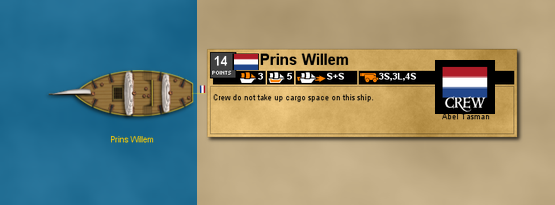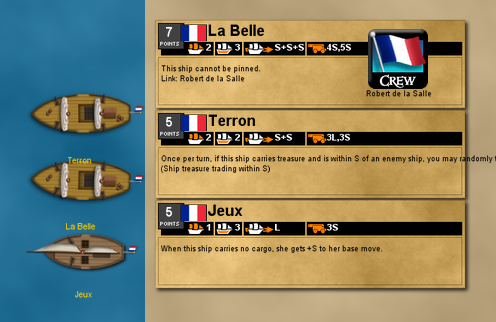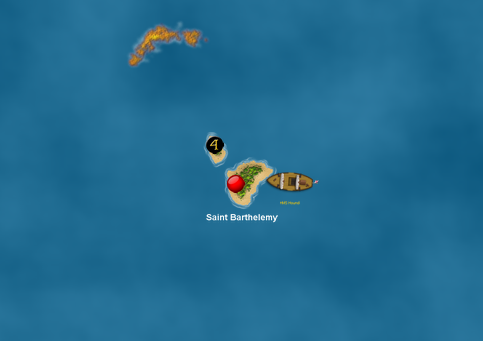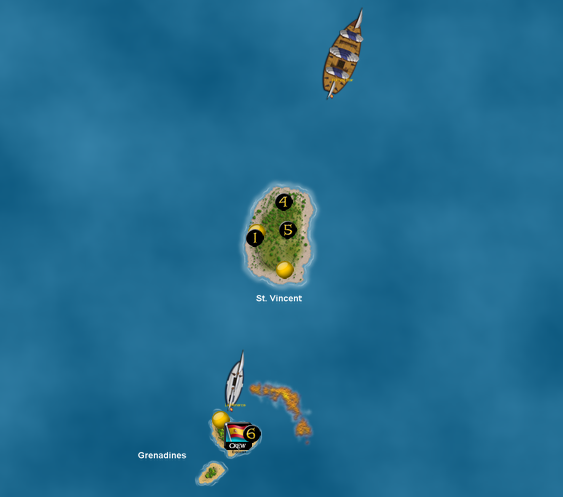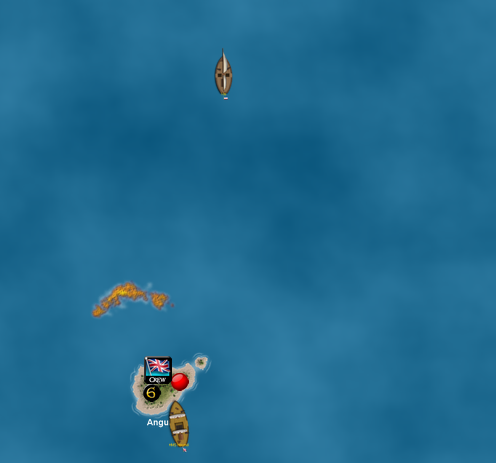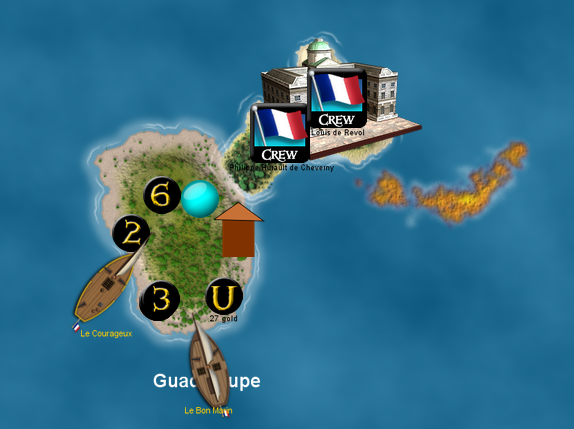Two of the greatest admirals in history, Admiral A7XfanBen and Xerecs, The Lord Sentinel, have begun their grandest adventure yet! After playing many campaign games over the years, including three together on the VASSAL module (CG1/2/3), we have decided to embark on something completely unprecedented, something no one has ever done. Something that is truly on a historic scale. A “game to end all games”, if you will. Ironically enough, this game may actually never end! Ever since the World game had to be put on hold, Xerecs and I have been planning this game as the replacement. However, we wanted to finish T2 first. Now that that’s over, we have been able to concentrate on this lately and are finally ready to start!
I couldn’t find the post, but for a few years now I’ve had vague thoughts of creating a complex, all-encompassing “Game of Life” based around Pirates CSG that would be my masterpiece. A game not just about naval warfare, but land warfare, politics, governments, trade, economies, revolutions, civilizations, home fronts, and more. Now that the World game has been put on indefinite “permanent” hiatus due to various technical issues, this game is the continuation of that idea. I mentioned it to Xerecs in one of our MANY emails about CG1, and the idea took off. I originally thought this “Game of Life” idea would come to fruition in many, many years from now (many decades actually). However, the VASSAL module (thanks again B.J. Olejnik!) has dramatically sped things up, and now my “masterpiece” of a game can see the light of day already! Xerecs and I spent parts of April and May 2016 developing the ruleset; what you see here represents hundreds of emails and only a chunk of the google doc we are using to collaborate. Ironing out the details has been a very fun and exciting process. We have recently edited the World ruleset to adapt it to the Caribbean game, though most of it has remained exactly the same.
Before I go any further, I’d like to point something out:
-There will be opportunities for you to play in this game as well. These will be known as “cameo” (or guest) appearances, and more information is at the bottom of this post.
The Caribbean game is just that, a game based on a map of the Caribbean. This is mostly possible through the VASSAL module, since creating an ocean large enough for such a map would require immense amounts of space and time (obviously not to scale, but even so it would have to be a HUGE ocean). With so many real life elements involved, the game is very loosely based on historical concepts, but NOT historical events (there will be no reenactments or reconstructions of history). These concepts form the backbone of many of the rules, and they also explain the need for a ban list for the game. However, it is still a game, so plenty of concepts will be cut out or underrepresented – to save time and effort, and also to focus on Pirates CSG, which is still the game’s core.
With the game file being saved at the end of every play session, this game has no timetable. Xerecs and I are both in our early 20’s, and you can see from our previous campaign game experience that we LOVE Pirates. As a result, this could sort of be “that game” – a game that goes on and on with no end in sight. A “forever-long game”, it could turn into just that. As of now we’re hoping to play for many years, though that could turn into multiple decades. Many things will get in our way, and we may have to put the game aside for months or even years at a time. However, we’ll always be able to return to it and resume playing once more. This also furthers the historical aspects of the game, since playing the game for many decades could represent decades or centuries of history, with the Age of Sail occurring in the general time period of 1500-1850. To put it simply, this thing has a chance to be BIG. Not just in terms of points in play, but in terms of impact and popularity as well. With enough complexity in the ruleset and enough time to play, it could turn into one of the most epic games in the history of gaming (tabletop/boardgaming/videogames/etc).
Without further ado, here is our ruleset. It is not a finished product and we will likely have to edit it once the game begins. Feel free to peruse at your leisure!
Tentative ruleset
Rulesets used: Economy Edition, Century of the Empires, RISK, Pirates of the Cursed Seas Campaign, The Pirates of Catan (Quick Reference Guide)
A HUGE thanks to cannonfury, sariouriel, captain_vendari, and woelf for creating those! Many parts of this ruleset directly borrows from the others.
Errata
Duplicates rule – There cannot be duplicate ships in play until a faction has purchased every single standard ship (including flavor duplicates (such as all three versions of the 5 master HMS Apollo, for example, but not including customs)) available to them. Once a faction has every ship in its fleet in play, that faction can launch duplicates. Only one duplicate ship is allowed; if a faction has two of every ship in play, they can begin a third set of duplicates. However, once a ship is sunk, it MUST be replaced before duplicates can be launched again. (This is also known as the “complete the fleet” rule)
-Named crew must be unique, but once a named crew is eliminated or removed from the game, a DIFFERENT version of that crew can then be purchased as long as they aren’t in play at the same time. This can be done ad infinitum; crew may be called “Thomas Gunn III”, for example.
-After a ship rolls for the resource type and loads resources, the ship will load face-up gold coins that correspond to the numbered resource (for example, a ship with lumber on board would have 1’s). When the ship unloads the resources at the home island, the 1’s (in this case) are swapped out for the value of the resource (IF they are being converted to gold). If the value of lumber was 4, when the ship docks at her HT (home territory), the 1’s come off the ship and face-down gold 4’s appear on the HT, which can then be used to purchase ships and crew.
-Players will NOT be required to pay one gold each turn for every ship not docked at their HI. Why? We want this game to be huge, so anything that slows the game down is getting cut out. I like this concept, since you have to pay the crew and supply them with food and rations, but for this game we can’t afford to be paying gold every turn when there are already going to be a ton of ships being launched all the time. Also, when this game reaches astronomical point totals, it would be extremely annoying to count how many ships each fleet had on their turns.
-Game time is measured in rounds. A round begins with the start of the first player’s turn and ends with the finish of the last player’s turn.
-Unique treasures may be used, but note that due to the nature of some rule changes, they may no longer function as intended.
-If 10 masters can be edited into the VASSAL module, no duplicate 10 masters will be allowed at any point during the game. In order to build a 10 master, you must capture a 10 master from another faction in order to get the hull and ship plans (the Jade Rebellion will be the only faction capable of launching a 10 master from the start).
-The Jade Rebellion is the only faction that can have duplicate 10 masters (still following the duplicates rule, and only the Baochuan) (Zheng He first version is linked, then have other crew for future linked admirals)
-Return to Savage Shores game pieces may be used.
-Custom game pieces may be used, as long as they aren’t too overpowered.
-Non-historical factions (Hylia/Gallia/etc) are not available
Ban list:
-All Events
-Whirlpools
-Navigators/trade currents
-Cargo masters
-Sea creatures
-Abilities that move enemy ships
-Strange/unfair UT’s (Bad Maps, Blood Money, Cursed Natives, Elizabeth’s Piece of Eight, Eye of Insanity, Gem of Hades/Red Skull, Homing Beacon/Jack’s Compass, Lost, Kharmic Idol/Pirata Codex, Maps of Alexandria/Pirate Globe, Maps of Hades, Necklace of the Sky, Neptune’s Figurehead/Resurrection Codex, Neptune’s Trident, Odin’s Revenge, Odin’s Revenge, Poseidon’s Breath, Runes of Destruction/Magic/Odin/Serpent, The Cursed, Voodoo Doll, Jailhouse Dog)
-Certain named crew (Calypso, Captain Davy Jones/Wraith (SS version), Cursed Captain Jack)
-Other completely impossible abilities (fog hoppers, Captain Jack Sparrow (UPS), Davy Jones (DJC), “Spyer” abilities (look at face down stuff on an enemy ship), Eternal, trading treasure, “other ships do not block this ship’s line of fire”, Turbine
Modified abilities:
-Pandora’s Box: Cannot be used to pull in any of the banned UT’s
-Periscope: Works within L, but not anywhere
-Ransom: In addition to the stated rules for Ransom, factions may now bring the Ransom crew back to a territory, port, or fort controlled by the crew’s faction. If the faction can pay, they must pay 100 gold (with gold from that area!); the gold is transferred via a “UT” worth 100 gold to the ship, and the Ransom crew can now be used again by the original faction.
-Ghost Ship: Cannot move through solid obstacles (islands, ships, and icebergs), but can move through fog, sargassos, and reefs
-“Ramming cannot eliminate this ship’s masts”: Changed to “This ship gets +1 to her boarding rolls” (both abilities should cost 2 points, and both refer to the ramming/boarding aspect of the game)
-“You own any derelict this ship explores; both ships become docked at your home island.”: Changed to “This ship gets +1 to her cannon rolls against any ship.”
-”Give this ship a move action but do not move her. Instead, roll a d6. On a result of 5 or 6, move an enemy ship L in any direction.”: Changed to “Captain. Reroll.”
-“Whenever any crew is eliminated, roll a d6; on a result of 6, assign the crew to this ship. Its nationality changes to match the nationality of this ship and it becomes linked to this crew.”: Changed to regular “Possession” ability (“If an enemy ship is within S of this ship, you can use this ship’s action for the turn to try to possess a target crew on that ship. Roll a d6; on a result of 6, the target is immediately assigned to this ship. Its nationality changes to match the nationality of this ship.”)
-“If this ship (sea monster) ends her turn in a fog bank, on her next turn she may use her move action to move out of any other fog bank in play.”: Changed to “This ship ignores terrain, except icebergs, when she is given a move action (islands are not terrain).”
-”Once per turn, this ship may look at any one face-down treasure on any ship or island.” (and variations of): Changed to “Once per turn, if this ship is touching another ship, reveal all treasure aboard the other ship. This ship can take as much unique treasure from the other ship as she can carry- even those that otherwise can’t be removed.”
-Eternal: Changed to “This ship cannot sink, but she can be scuttled.”
-”After looking at treasure on a wild island, you may trade any one treasure from that island for a random treasure on any other wild island. This ship must load the traded treasure.”: Changed to “Once per turn, if this ship carries treasure and is within S of an enemy ship, you may randomly trade one treasure with that ship.”
-“Other ships do not block this ship’s line of fire”: Changed to “You may double the range of this ship’s cannons each turn, but you must roll a 6 to hit.”
-“If a sea monster begins its move within L of this ship, it gets +L to its base move.”: Changed to “This ships gets +L to its base move. This ship cannot be assigned a helmsman.”
-Calypso: Once per turn, give any ship in your fleet +L to it’s base move that action.
-Cursed Captain Jack: Parley. Canceller.
-Captain Jack Sparrow: Captain. Parley.
-Davy Jones (DJC): Changed to OE Davy Jones (All-Powerful)
-All-Powerful: A roll of 6 is effectively a 5 – you may give any ship in your fleet an extra action.
-Any abilities that refer to boarding bonuses against sea monsters are applied to ships instead.
Temporary ban list:
These items will only be allowed after a certain amount of time has passed or a specific milestone is reached.
-”Instead of giving this ship an action this turn, you can give another ship in your fleet two actions.” (Available after the first 100 rounds have passed)
-Native canoes/chieftains (Available after a faction has discovered the New World territories in the far west of the map)
-A faction cannot have more than 4 sets of native canoes (20 total) in play at the same time (this is to reduce lag)
-Native canoes may only be launched at military ports. The first set of native canoes that a faction “receives” will be a custom ruling, likely involving bribing the local natives and/or impressing them with a display or riches or firepower.
-Flotillas (TBD; likely not available for multiple years)
-Hoists (TBD; likely not available for multiple years)
-Submarines (TBD; likely not available for MANY years)
Starting conditions
-There will be 4 factions starting the game, and the order of play will go as follows:
Xerecs:
English
Spanish
A7XfanBen:
Dutch
French
-Fleets start out at 20 points. Each faction also gets one infantry unit to start the game. Factions must keep at least one infantry unit in their home territory at all times. All of the other territories will be “empty” (they will contain unknown resources and gold) at the start of the game. Despite the rules for shipyards, any ship type is allowed for the first starting fleet.
-A custom VASSAL ocean called the “Caribbean Map” will be the setting. This ocean will be the largest ocean ever used for a game of Pirates CSG, and will feature a ton of real-world locations, with many of them based on history (especially 1500-1850).
-Factions will not start the game with a home island. Instead they will be sailing into the region from the far east, as the Caribbean has only recently been discovered. We are vaguely pretending that the year is approximately 1500, but this is not particularly important or relevant to gameplay. All four factions will start at the eastern edge of the map according to their historical locations in Europe. From north to south: English, Dutch, French, and Spanish.
-Once a faction establishes a home island, that island can produce only one resource per turn. Once a faction has upgraded all of their structures to Level 2, the island can produce 2 of that resource per turn.
-Other factions will not be present at the start of the game. The Mercenaries will be available for hire as privateers, as detailed below.
Resources
Resources are the main source of gold production in the game, but must first be converted for a variable price at the home island into treasure coins, which can then be used to purchase ships, crew, equipment, etc.
Resources count as cargo, and abilities that affect treasure coins also affect resources (i.e. each of these coins is worth +1 gold… turns to each of these resources is worth +1 of whichever resource is in question).
The value of a resource is determined by a die roll. At the beginning of the first player’s turn, a d6 and two d6 are rolled. The d6 roll determines the values of all resources (refer to the quick reference for exact values) while the pair of d6 rolls determines the number of turns this value will hold.
Lumber: (1) Fundamental for ship and settlement building, lumber is the basic building block of any naval civilization.
Textiles: (2) Needed for sails and clothing, textiles are a key part of the trading industry.
Metals: (3) Stronger than wood, metals allow for the construction of sturdier ships and deadlier weapons—as well as providing the means for paying for them.
Food: (4) From fish to spices, food is an essential part of every nation’s economy.
Medicine: (5) Derived from various sources, medicines are essential for having a healthy military.
Luxuries: (6) The rare items crews find on their journeys through the world’s seas—from the beautiful to the wild to the truly cryptic.
Die Roll…….1……2…….3…….4…….5…….6
Lumber…….1……6…….5…….4…….3…….2
Textiles…….2……1…….6…….5…….4…….3
Metals………3……2…….1…….6…….5…….4
Food………..4……3…….2…….1…….6…….5
Medicine…..5……4…….3…….2…….1…….6
Luxuries……6……5…….4…….3…….2…….1
Specific resource abilities
When 20 or more of these resources are at your home territory OR port, they give you special bonuses. Resource bonuses do not stack. Only one of these abilities can be used at a time. In order to change abilities, the resource in question must be decreased below 20 to select a new one. If these abilities combine with other abilities (such as those from political parties), nothing can ever cost 0 gold. 1 gold is the minimum cost for any purchase.
Lumber: (1) Ships cost 1 less gold than their point cost (point costs don’t change for all other purposes). Shipyard upgrades cost 5 less gold.
(Ships and shipyards both require vast amounts of lumber)
Textiles: (2) Ships cost 1 less gold than their point cost. Gain 1 loyalty per turn.
(Sails are used for the ships, and a great clothing industry keeps the populace happy, especially during winter time)
Metals: (3) Fortress upgrades cost 5 less gold. Army units cost 1 less gold.
(The fortress houses many guns and an armory, and that armory produces guns and swords for the soldiers, hence the lower cost of army units)
Food: (4) Army units cost 1 less gold. Gain 1 loyalty per turn.
(The faction does not have to supply the army with as much rations, and a healthy food market keeps the populace happy)
Medicine: (5) Gain 1 loyalty per turn. If a civil war occurs, the populace is decreased by 25%, rather than 50%.
(A healthy populace, and one that can bear disasters better than the average populace)
Luxuries: (6) Ransom payments can be for 50 gold instead of 100. Named crew cost 1 less gold.
(Thematically luxuries could be swapped for gold (you don’t have to fork over the luxuries during the ransom exchange), and giving named crew different jewelry and valuables could entice them to join your cause)
In regards to that “OR port”, it basically means that if you stockpile 20 or more of a specific resource at a military port, the bonus kicks in IF POSSIBLE. If a military port resource bonus ability says “gain loyalty”, nothing happens because the populace is way back in the HT. However, a military port could benefit greatly from the lumber resource bonus, since ships can be launched at MP’s and each MP will have its own shipyard, upgraded just like the shipyard(s) at a HT.
Theoretically each resource type should account for 16.67% of the territories and islands in the game.
These resource bonuses will not be applied until we are 20 turns into the game.
-If 10% or less of the islands produce the same resource, that resource is worth 1 more gold than usual.
-If 5% or less of the islands produce the same resource, that resource is worth 2 more gold than usual.
-If 50% or more of the islands produce the same resource, that resource is worth 3 less gold than usual (to a minimum of 1).
-If 33% or more of the islands produce the same resource, that resource is worth 2 less gold than usual (to a minimum of 1).
-If 25% or more of the islands produce the same resource, that resource is worth 1 less gold than usual (to a minimum of 1).
-An island’s resource will be represented by one of the tiny dice, which will be turned upright to the corresponding number. (In the VASSAL module, we will use face-up coins.)
-Nations can “make change” with their gold or resources.
-Factions are allowed to purchase resources from other factions. (and really anything else agreed upon for that matter)
-Certain islands or territories may have predetermined resource types on them, based on history.
-Some locations will also contain regular gold, especially locations that were/are historically rich with gold. To minimize potential lag within the module, most of the gold will not be present at the start of the game, but added when ships or troops discover it.
-If a wild island is very close to a faction’s home island (about 6S but especially less than that, with one or two move actions required to get there), that island will almost never produce resources due to the potential for abuse.
-Random timer idea (for resources changing, weather, etc.): At various points throughout the game, all players may agree to use a random timer for that session. When the timer goes off, roll for resource values as normal. Those values hold until the end of the session, or until the timer goes off again.
-Players may agree to change the resource system. Instead of simply rolling a d6 for values and two d6 for duration, other options may be added for more randomness.
Example: A round of turns begins with the d6 roll. A 1 is rolled (on a 2-6 the resources stay the same, until a 1 is rolled). Since a 1 was rolled, roll again. If the second roll is a 2-6 (anything other than a 1), the resources only change value for that turn. On the next turn, they revert back to whatever they were on the previous round, or a different system is once again agreed upon by all players (such as starting over with regular EE rolls, or using the system described in this example). However, if the second roll is a 1, the current EE rolls are disregarded, and new rolls are made (both for values and duration).
Changing the rules for how resources change could really make things interesting.
-Alternative economy rules may also be used.
Upgrades
Home Islands/Territories
Factions must build structures in order to establish their presence in the game. After a faction settles on a home island or territory, they must pay 10 gold in order to purchase any Level 1 structure (except for Cities). These structures may be upgraded, and factions can construct multiple shipyards and fortresses on their home territory (up to 4 of each, subject to change). These structures must be within L of the coast. Upgrades to home islands and upgrades to wild islands happen at the end of a faction’s turn during the launch/spending phase.
Shipyard:
Level 1: 1 masted ships, 2 durability points, 20 gold to upgrade
Level 2: 1-2 masted ships, 4 durability points, 20 gold to upgrade
Level 3: 1-3 masted ships, 6 durability points, 30 gold to upgrade
Level 4: 1-4 masted ships, 8 durability points, 40 gold to upgrade
Level 5: All ships, 10 durability points
The price of a ship is its point cost. When you purchase a ship, place only its hull at the shipyard. During each of your turns, that ship may be given build actions (only) to place masts until it’s been fully constructed. Shipyards can only build a number of ships equal to their level (ex: a Level 3 shipyard can build up to 3 ships simultaneously). Ships under construction can be shot at, but not rammed or boarded. If the port or shipyard where a ship is being constructed is destroyed, construction immediately halts and the ship may be given actions as though construction were complete.
-Each additional HT shipyard costs 50 gold
-Factions can have up to 4 shipyards (subject to change)
-Crew cannot board a ship until it has been fully launched.
Tavern:
Level 1: Generic crew and equipment, 2 durability points, 20 gold to upgrade
Level 2: All crew (named crew, generic crew, and equipment), 6 durability points
Fortress:
Level 1: 4x4L cannons, 4 durability points, 20 gold to upgrade
Level 2: 4x3L cannons, 6 durability points, 20 gold to upgrade
Level 3: 6x3L cannons, 10 durability points
City:
-Each faction will have a “city” similar to their other structures. The faction’s city represents its populace. Factions start at level 0, and each upgrade costs 50 gold.
Level 1: Add 3 to populace at the beginning of each turn.
Level 2: Add 5 to populace at the beginning of each turn.
Level 3: Add 10 to populace at the beginning of each turn.
Level 4: Add 15 to populace at the beginning of each turn.
Level 5: Add 20 to populace at the beginning of each turn.
City Hall:
See rules for “Government” underneath Updated/New Mechanics; City Halls cannot be upgraded.
-There are now game pieces in the VASSAL module that can be used to represent these structures; however, some of them may not be used in the interests of minimizing lag. In addition, they were designed with the World game in mind, so the structures will not fit properly on single island pieces. It is likely that simple face up coins will be used instead.
Islands
An island upgrade is bought at the home island; a token representing that upgrade and 10 gold used to pay for it can be loaded onto any ship(s); the token fills one cargo space. That ship must return to the previously explored island and may unload the token and 10 gold as a free action. The island is immediately upgraded, but it cannot function normally until the following turn (similar to forts). If a ship is sunk on transit, the token is lost and another must be purchased.
-Settlement: Automatically created after an explore action. Abilities that remove explore actions can eliminate settlements. Settlements simply mark that this island has been explored by the player; enemy settlements may exist on the same island.
-Fort: A settlement may be upgraded to a fort. However, a faction must physically sail the gold to the island where the fort will be built in order to construct it. A fort generates no resources. Generic crew may be hired at this island. Resources can be unloaded at a fort, but they cannot be converted.
-Colony: A settlement may be upgraded to a colony by paying 10 gold. Abilities that remove explore actions do not eliminate colonies. Having a colony on an island gives control of that island to a player; other players may no longer take resources from that island. Colonies can be razed by enemy ships, they have no natural defenses and after three hits are considered destroyed. A colony may also be captured through a boarding action. Once destroyed, the island becomes unexplored in regards to all players, and its resource value may be reset.
-Port: A colony may be upgraded to a port. Players have a choice between either a trading or a military port; an island can only accommodate one. When upgrading to a port, that faction must bring the upgrade token to the colony in addition to 10 of the gold they used to purchase the upgrade. The 10 gold is removed from play when the token is unloaded at the island as a free action.
1) Trading Port (30 gold): Allows a player to trade any one resource for one other resource, of any type. An opposing player’s ship may also dock at your trading port to trade commodities, but they must pay one resource to the owner in addition to the resource(s) being traded. Ships with the Parley keyword do not have to pay this fee. A trading port can be blockaded by any ship. A trading port has 5 durability points; a sixth hit will eliminate it. Trading ports may be given repair actions – if so, no resources can be exchanged that turn. A trading port may use one lumber to repair itself, in which case resources can be exchanged that turn.
2) Military Port (100 gold): Allows a player to repair ships docked at this island as if it were a home island. Crew and ships may be purchased at a military port using gold from the port. A military port can hold resources and gold. A military port generates no resources. A military port cannot be blockaded, and acts as an eight flag fort with 3L cannons. In terms of purchasing ships and crew, a military port starts with a level 1 shipyard and tavern. The shipyard can be upgraded the same as home territory shipyards, but the tavern cannot (no named crew hired at military ports).
-In addition to the gold cost of island upgrades, when a colony upgrade is purchased, the populace decreases by 2 (to represent people leaving the HT). When a port upgrade is purchased, the populace decreases by 5.
-An island can only have one upgrade on it at a time.
-Upgrades must happen sequentially – factions cannot upgrade from a settlement to a port in one turn. This applies to HT upgrades as well – factions must upgrade their structures one level at a time. An upgrade of any kind takes a turn to institute.
RISK
-Territory/island can be used interchangeably at this point.1. In the map of the Caribbean, we have placed 11 non-island territories that form the coast of the New World continent. In addition to the group of territories, there will also be MANY islands. These islands (not territories, so therefore essentially irrelevant to the Risk part of the game) function as wild islands, but they can have units from Risk placed on them. Due to space constraints, some locations will be absent or underrepresented.
2. All of the non-HT territories that are bordered by only water will start the game as wild islands, unless chosen as a home territory by a faction. These territories follow the normal rules for wild islands. All of the territories except for the home territories in the game will start as “wild”. This means that resources and gold can be acquired over land by armies.
3. Each faction has a home island or home territory. Home locations can be conquered, but a faction is not automatically eliminated if their home is taken over by an opponent.
4. When invading an enemy territory across water or reinforcing a friendly territory across water, the army units must be transported by ships. There are no lines from RISK that connect territories over water – armies cannot invade across water unless they are transported in ships. That being said, ships have no limits on where they can transport army units.
5. Invasions follow the standard rules for Risk, and combat due to an invasion happens as soon as the units disembark from the ships. In order to land the troops on the territory, an explore action is needed, unless the territory is friendly and/or has been invaded before (home territories do not require an explore action to land troops there if it is the landing player’s home territory).
6. Risk units cost 3 gold each (or 3 points). This may be adjusted during the game if needed. For the purposes of abilities and effects, army units are considered ‘crew’ when on board a ship, even though they have no abilities. However, they do not count against the ship’s point cost. When a ship loads army units, they take up one cargo space per unit. They can be loaded and unloaded like normal crew with the following exception: An explore action is required in order to load or unload army units. For flavor purposes, one unit represents 100 troops.
7. Ships can fire on army units on land (following the regular procedure for a shoot action) if the units are within S of the ocean. The number of hits needed on the same turn to eliminate a unit is the same as the number of units the piece represents (infantry=1 unit, 1 hit needed to eliminate, cavalry=5 units, 5 hits to eliminate, artillery=10 units, 10 hits in one turn to eliminate). This is a way to incentivize saving up for artillery, which became more important in land warfare as the years went on. Infantry and cavalry units cannot fire back; however, if a ship misses an individual unit three times in a row in a particular shoot action, she loses a mast. Artillery units (representing 10 army units) can function as a 2L cannon for coastal defence. If an artillery unit is given a shoot action to shoot at a ship, it cannot be given a move action that turn. Ships cannot shoot over an island to hit a territory beyond, no matter what range her guns are.
8. In addition to the regular rules for forts, the rules for forts regarding land attacks are as follows: Army units can attack forts from land, in this way they must have already invaded the territory. A fort’s flags represent its defenses multiplied by 4 (a 4 flag fort functions as 16 army units). The rules for combat work the same, with the exception that due to the fortifications, the defender can roll up to three dice. The fort can contain army units of that particular faction, as a means of protecting them. The fort serves as the last line of defence if placed on a territory bordered by land. (These rules also apply to trading ports and military ports, with 6 and 9 durability points respectively.)
9. There are three custom forts that I have designed for the game – forts that were key strategic points in real-life campaigns. These forts are stationary. They cannot be placed on any territory/island and rebuilt on other territories/islands later in the game. Other than that, they function as regular forts. Once the ocean is created, their stats and abilities may need adjusting. In addition, more stationary historical forts may be created.
Gibraltar (Gibraltar, located on the southern tip of Spain)
72 gold (6 times the original cost of 12 gold), 10 guns: 3S, 2L, 2L, 2L, 2L, 2L, 2L, 2L, 2L, 3S. Ability: When this fort hits an enemy ship, you choose which mast is eliminated. Once per turn you may double the range of ONE of this fort’s cannons.
Diamond Rock (off the southern coast of Martinique)
24 gold, 2 guns: 2L, 2L
Ability: Extended Range.
El Morro (Havana, Cuba)
48 gold, 8 guns: 3S, 2S, 2L, 3L, 3L, 2L, 2S, 3S. Ability: This fort’s L-range guns cannot be eliminated.
10. Unlike the regular rules for Risk, territories can be abandoned. However, a faction cannot abandon their home territory under any circumstances. They can move most of their units and/or ships and gold to another territory to avoid being annihilated, but they cannot abandon their home territory.
11. When moving army units, each individual unit can only move from one territory to another once per turn. If units are part of a successful invasion, they cannot immediately move onto the next territory and invade it as well. Units can only move into one territory at a time (once per turn) even if the territories they are moving through are abandoned. When fortifying their position, a player can only move from one territory to an adjacent territory.
When army units move to acquire gold or resources, each unit has one cargo space (ex: three army units moving together can carry up to three lumber). When carrying resources/gold, army units cannot attack, but they can defend as normal.
12. There are no reinforcements from the number of territories or continents a player controls. Since players are supposed to pay for their armies, there will be no free reinforcements – players cannot bypass the cost of army units.
13. No cards from Risk are being used. There will be no reinforcements.
14. Each faction gets 10 free army units for home territory defense ONLY. These units cannot be removed from the HT, and are not represented on the map because they are part of the populace. They can only be used if another faction invades their HT.
15. Army units cannot move into a territory and explore it in the same turn. They must be given an explore action.
16. Similar to the RISK rules for army unit movement, crew and politicians can move across land. A move action can be used to move through one adjacent territory at a time. Equipment can be carried by army units; one piece of equipment takes up one cargo space.
17. Mercenary army units can be hired at military ports for twice the usual cost of army units. (faction bonuses/minuses at the HT do not apply – Mercenary army units always cost 6 gold per unit)
Action modifications
-Explore Actions: An explore action at a wild island takes an action, as usual. When a wild island is explored for the first time, the player that performed the action rolls a d6—match the result to the number of the corresponding resource. That island now produces that resource for all players, and you may load tokens of that resource onto the ship up to its cargo limit; each token fills one cargo space. Abilities that remove exploration markers may reset the resource of an island.
-Repair Actions: Repair actions occur normally, with the exception that a ship carrying both lumber and textiles may repair a mast at a wild island, per the shipwright rules; these resources are used in the process. Also, a shipwright stationed at a fort or military port may use the fort’s action for the turn to repair one cannon per turn.
-Combat Actions: Combat actions occur normally, although boarding actions have received updates and new actions, blockading and razing, have been created.
Updated/New Mechanics
-Boarding: after a successful boarding action, the winning ship may, in addition to taking gold or killing crew, take resources of any type up to their maximum cargo space. A settlement can be considered to have 2 masts in a boarding roll, and is captured by the winning ship. If a ship loses a boarding roll against a settlement, the attacking ship must remove a mast and move S away.
-Blockading: A trading port can be blockaded by a ship. If a ship docks at a trading port and declares hostilities, that port is considered to be blockaded; all trading ceases and the player loses all bonuses, including the production of commodities. The blockading player gains the resource bonuses, and can choose to take resources up to their cargo limit or remove them from the game.
-Military ports and HT’s can be blockaded, which results in the blockaded faction losing any resource bonus abilities they had until the blockade ends.
-Razing: A trading port can be razed with a boarding action; it is considered to be a 4 mast ship. If the boarding ship wins, the trading port is removed from the game, and the boarding ship receives all the resources available, up to that ship’s cargo limit. If the trading port wins, the opposing player takes that ship, but all crew on board are removed from the game. (Military ports cannot be razed)
-Raiding: A ship with the home-island raiding ability can dock at an enemy home island and take as many resources as she can carry, in addition to any gold. If able, she must leave on her next turn.
-Privateering: Once a trading port has been established, Mercenaries may be hired by the major nations as privateers. The ship or crew is bought for gold worth its build cost at the trading port, with gold in the trading port paying for the cost. The ship comes into play immediately at that island; it is considered a member of your nation for all purposes except that once it docks at a friendly home island or trading port, it is removed from play, along with any crew of the same nationality aboard. It may be hired again once it has been removed from play for the same cost. If a Mercenary ship sinks, that player cannot rehire that ship until a different player has hired the ship and it sinks as well.
Taxes and Loyalty
-Factions can levy a tax on their populace. Each faction’s populace is based on their city and how many political parties exist in their city hall. For flavor purposes, each number or “unit” of the populace represents 10,000 civilians (ie. a faction with a populace of 1,000 represents a country of 10 million people).
-The number of the tax rate is the amount of gold (up to 6) that faction receives at its home territory at the beginning of each turn.
-The tax rate can only move up or down by 1 gold at a time.
-When a faction declares a new tax rate, that tax rate must remain constant for 5 turns.
-A faction’s loyalty (of their armed forces and populace) can rise and drop. This is based on the tax rate and other factors. When taxes are raised or lowered, the corresponding drop or increase in loyalty occurs over the course of 5 turns. Loyalty cannot drop below 0 or rise above 100.
-Factions can only tax their populace if it is greater than 200.
-If the populace falls to 0, there cannot be taxes, and army units and crew cannot be hired.
-If a faction’s loyalty is between 60-79, that faction can add 1 to their populace per turn.
-If a faction’s loyalty is 80-99, that faction can hire crew for 1 less gold.
-If a faction’s loyalty is 100, that faction can add 2 to their populace each turn. Army units cost 1 less gold.
These effects do not stack, and occur at the beginning of the faction’s turn.
The chart below illustrates how loyalty changes with the tax rate. If the tax rate is at 6 for 10 consecutive turns, desertion will occur. 5 units desert per turn starting on the 11th turn of the 6 gold tax rate. If they go into the negative they have to pay for the units until they have a zero balance, after which they can once again purchase army units.

If a faction’s loyalty drops to 0, roll a d6. On a 1-2, there is a civil war. On a 3-4, there is a revolution. On a 5-6, there is a government overthrow.
Civil war
-The faction crumbles into a civil war between the opposing parties involved. The faction’s populace is cut in half. Divide the faction’s home territory into two areas. Each half gets half of the army units present in the home territory. On the faction’s next turn, the civil war begins. The two sides square off in battle, following the regular RISK combat rules. Battles continue until one side is victorious, ending the civil war. While the civil war is being fought, any ships within L of the home territory fire upon formerly friendly vessels.
Revolution
-The current political party and its supporters in the populace face a revolution by the opposing party. If there are over 50 army units in the HT, the rebellion is quelled and nothing happens. If not, the current political party is eliminated along with their leader. The faction must now function without a government (see below) for 2 turns, after which time another election can be held.
Government overthrow
-Eliminate the entire political party currently in control of the faction. Replace that party with a new party and leader, following the rules for elections (hold one election between the two parties next in line). The tax rate is decreased to 0 and cannot be raised for 10 turns. The loyalty is increased to 100 and can decrease from there.
If the eliminated party is the last party in the city hall, the faction must now function without a government until a new one is hired or planted. In that case, there cannot be taxes, but the faction also cannot buy army units or ships at their home territory.
Government
Each faction will have a city hall, where their government resides. There is no limit to how many different political parties a faction has in its city hall. However, each political party introduced after the initial number results in a loss of 5 loyalty. In addition, each political party introduced after the initial parties adds 20 to the populace.
Each political party will have a leader. This leader will be represented by a crew, and will function similar to regular crew. The politicians will have specific abilities pertaining to their strengths and weaknesses. Most politicians will have abilities that can ONLY be used while in the faction’s HT, but some will have abilities that function while at sea. Land abilities cannot be used while at sea, and sea abilities cannot be used while on land.
To introduce a political party, a faction must hire that party’s leader for a gold cost. Every politician that can serve in government must be paid 5 gold when “hired” in addition to the regular cost of the “crew” (the cost of their actual abilities). This brings that political party into play; they and their leader are placed in the city hall. Once in the city hall, they can begin participating in political elections.
Elections
Once every five turns, a faction can have their city hall host an election. Select two political parties and roll a d6 for both of them. The party with the higher result either advances in the governmental system (similar to a tournament bracket) or becomes the leader of the faction (if it was a final election). If a new party comes to power, their abilities and the abilities of their leader come into play and replace the abilities of the old party. Political parties and leaders can only use their abilities when they are in power. If a final election is held when the loyalty is 80 or higher, the party in power gets +2 to its die roll in the election. There can also be elections within parties, to determine which candidate of a party becomes the leader of that party. If a faction has 4 or more parties in their city hall, elections can happen every 3 turns. If a faction has 8 or more parties in their city hall, elections can happen every 2 turns.
Political parties and their abilities:
-These will be the abilities of each political party, which only activate when the party is in power. Political leaders will have their own individual abilities.
Land party: Favors land warfare and expansion.
-Army units have a base cost of 2 (instead of 3). Ships’ point costs are doubled.
Sea party: Favors naval warfare and expansion.
-Army units have a base cost of 5. Captains and helmsmen only cost 1 gold each.
Home territory party: Favors building up the HT through upgrades and a strong home army, as well as a large populace.
-All home territory upgrades cost 10 less gold than usual.
Exploratory party: Favors exploring every corner of the world, at any cost.
-Army units have a base cost of 4. Three explorers can be hired for just 1 gold. Helmsmen cost 1 gold.
Imperial party: Favors aggressive colonial expansion, and declares war on other factions often.
-The cost of island upgrades are cut in half. Every 5 turns, declare war on a faction.
Colonial party: Favors having as many colonies as possible, and having strong upgrades on them such as ports and high-level shipyards.
-The cost of island upgrades are cut in half. Decrease the populace by 2 each turn.
People’s party: Favors increasing the populace, having very low or no taxes, and preserving the safety of the home territory.
-City upgrades cost 25 gold (instead of 50). The tax rate cannot exceed 2 gold. Island upgrades cost twice their normal amount.
Religious party: Favors going to war with specific factions whose religion conflicts with their own.
-Assign a number to each faction. Use a random number generator to choose a faction. Declare war on that faction. Pursue peace treaties and armistices with all other wars.
Upgrade party: Favors upgrading all structures, including those on colonies, before building up the army and navy.
-Halve the cost of all upgrades. Double the costs of ships and army units.
Trade party: Favors resources over gold, and pursues profitable commercial relationships with other factions.
-Halve the value of all gold unloaded at the home territory. Halve the cost of trading ports. Pursue commercial alliances with the factions you can profit most from.
Gold party: Favors gold above all else, including resources and actually spending that gold.
-Double the value of all gold unloaded at the home territory. Halve the value of all resources unloaded at the home territory. Cannot spend more than 20 gold per turn.
Power party: Favors an absolute monarchy/dictatorial state. Works to eliminate other political parties from contention. Potentially high taxes but a very clear sense of purpose. (centralized decision making)
-Hire political assassins to eliminate other parties from the city hall. When this political party comes into power, roll a d6. On a 1-3, loyalty drops by 20 immediately. On a 4-6, loyalty does not drop when taxes are increased. Cannot issue bonds.
Resource party: Favors collecting a specific resource, depending on the leader’s preference.
-Roll a d6. The result is the resource type that now doubles in value for this faction only.
Region Party: Favors having absolute control of a specific area
Abilities: Roll a d6. This number is the particular region the party is trying to control (refer to chart). Generally the lower the number, the more difficult it will be to control the region. There will be benefits for establishing and maintaining control of a region when the Region Party is in power.
-The cost of military ports are halved in the specific region. Any ships and army units not in the specific area get -1 to their cannon and combat rolls (only).
-We are still figuring out the specifics of this political party.
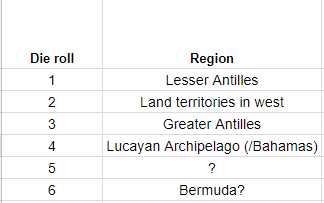
There will likely be other parties as well.
-Once every 10 turns, a faction can plant a political party and leader inside the city hall of another faction. This can be used to help that faction, or to hurt them. The leaders of these planted parties can have secret abilities known only to the player who planted them. The player must reveal the secret ability when they intend to use it. This is a way to simulate assassinations, though other possibilities exist as well. (Example of a secret ability: Select a political leader in this city hall. Roll a d6. On a 4-6, eliminate that leader from the game.)
-Sometimes there will be a frontrunner in the political race. That party will get to double its election rolls, but will disappoint the populace and therefore have subpar abilities. On the other hand, a party may have its rolls halved for elections, but might have very worthwhile abilities.
There will be a trade-off between loyalty, populace level, taxes, and long-term agendas. More political parties mean less loyalty, but a higher populace could give a faction the ability to tax. Introducing more political parties also increases how many elections there can be, but that can lead to high turnover in terms of government, which can hinder a faction’s overall progress.
Bonds
Factions can issue bonds to receive money from their populace.
-Bonds are an immediate influx of gold.
-A faction can receive a maximum bond value of 10% of their total populace (ex: a faction with a populace of 1,000 cannot receive a bond worth more than 100 gold)
-Factions must repay the value of the bond plus interest. Interest is paid at the end of the period.
-The minimum period of a bond is 10 turns. There is no maximum period.
-The interest rate is tied to the period. A 10 turn bond has a 10% interest rate. 10 turns after issuing the bond, a faction must pay 110 gold back to the populace by eliminating the gold from their home territory (following the 100 gold example).
-Factions are not required to issue maximum value bonds; they can receive gold equal to less than 10% of their populace value, but never more than 10%.
-Only one series of bonds may be issued at a time. More bonds cannot be issued until the current ones are paid off.
-If bonds are not paid back, loyalty drops by the amount that isn’t repaid.
Example: A faction has a populace of 1,186. The maximum amount they can get for their bonds is 119 gold. However, they don’t think they can pay back 131 gold in 10 turns, so they opt to receive 80 gold, with a 15 turn period. In 15 turns, they pay 92 gold back to their populace. If they can only pay most of the bond payment (70 gold), loyalty drops by 22.
Rumors and Missions
Named crew (only) may try to acquire rumors or missions, which may help them or their nation. Rumors are usually more esoteric or selfish in nature, while missions are more obvious and “patriotic”.
-Rumors may only be obtained while docked at another faction’s settlement or trading port (not colonies).
-Missions may only be obtained while docked at the fort or military port of the ship’s faction.
To acquire a rumor or mission, roll two d6. Add the results, and compare it to the point cost of the most expensive named crew on the ship. If the sum of the dice is lower than the point cost, that named crew has been successful. Place a Unique Treasure representing the rumor or mission on the ship’s deckplate. Rumors and missions are kept face down, but they do not take up cargo space. Rumors may be stolen as regular “treasure”, but missions cannot be stolen by any means. If a ship with a mission is captured or sunk, the mission is eliminated. If the named crew is eliminated, the rumor is eliminated as well. (Rumors are tied to their named crew; missions are tied to the crew and the ship.)
-There will be a neutral merchant ship that sails around once in awhile. This ship will be a 4 masted ship with L speed and 8 cargo spaces. All 8 cargo spaces will be filled up with one resource type. Ships can engage this merchant ship to trade goods on a 1:1 basis. The merchant ship cannot shoot or be shot at. Once all of the original resources are gone, the merchant ship leaves the game, but may reappear again.
Victory Conditions
-There are no victory conditions. This game is not expected to end.
House Rules
-Factions must meet at sea or on land in order to exchange information, or send messengers. The players of the game cannot simply speak to one another or send messages through the module chat.
-NO TELEPORTATION! (of any kind)
-All ships must be hit twice in the same turn to eliminate one of their masts. This ability also applies to ships such as El Acorazado, whose ability now reads “four hits are required to eliminate one of this ship’s masts” (not necessarily the same shoot action). In some of the larger battles, this may become difficult to keep track of, in which case we will use the “same shoot action” rather than the “per turn” ruling. In VASSAL, we are tentatively planning to use pennant flag markers to denote that a ship has been hit before the second hit eliminates a mast.
-Ships cannot do damage by ramming.
-When a ship wins a boarding party, the winner decides whether they will take gold/resources or eliminate crew. The winner chooses which gold/resources to take, but the loser chooses which crew is eliminated.
-Ships can be shot at while docked at their home islands.
-Marines are now a generic crew. They cost 5 points, and simply have the Marine keyword. Named marines cost the same as usual, but they get two shots per shoot action instead of one. Since generic marines are generic crew, they are subject to the no-stacking rule. However, named marines work the same as normal – they can stack. If multiple generic marines are present on the same island or territory, they can all be given shoot actions.
-Forts now cost 6 times their normal gold cost, with the exception of Paradis de la Mer, which costs 30 gold.
-When an enemy ship comes within range of a fort’s guns, that fort may fire ONE cannon.
-Forts can now be set on fire.
The rules for flaming forts will work like this: instead of the fort rolling for each fire every turn, it rolls one die regardless of how many fire masts it has and regardless of whether the fort is given an action during the turn. The roll follows the regular rules for fire masts. The fort will be automatically destroyed if the fire consumes all 8 areas (not how many guns the fort has). A shipwright can only put out one fire per turn, but no flag is raised in the fire’s place until another repair action is given.
-Incentivize captures – possibly an answer to the problem of sinking ships (ships sink more in Pirates CSG games than they did in real life combat). When a ship is captured, that faction can “rechristen” the ship as one of that nation’s ships instead once the captured ship is fully repaired, and pays the difference in gold cost. Ships exchanged in this manner MUST be of the same ship type. Factions do not get any kind of gold or resource bonus if the captured ship is worth more than the ship they are converting it to. If brought back to a shipyard that is not an adequate level (for example, bringing a captured 4 master back to a level 3 shipyard), the faction must upgrade the shipyard in order to rechristen the ship. (The normal rules for capturing ships still apply, and therefore it may be more advantageous to not use this rule and simply keep the captured ship and change it’s nationality flag.)
Very simple example: the Pirates capture the Couer de Lion from the French, tow her back to their home territory (or a military port where they can legally launch ships from), repair her, and “exchange” her (simply editing the stats) for the Banshee’s Cry by paying 1 gold for the cost differential.
-Factions can send ships back to their home countries in Europe for reinforcements. This is done by sailing at least one ship off the eastern edge of the map; it is removed from play. The ship(s) must roll for effect on one of Xerecs’ storm terrain on their way to Europe. The faction may get free reinforcements while out of play after arriving in Europe. If one ship reaches Europe, they can get up to 100 points of ships and crew. If two or more ships reach Europe, they can get up to 200 points of ships and crew. It takes 100 turns to reach Europe, and a number of turns equal to the largest new ship’s mast count to launch the reinforcements. It will then take another 100 turns to return to the eastern edge of the Caribbean in the same spot as the faction started the game in. Each of the starting factions can only do this once per game.
-Factions can transport lumber for use as fire beacons. This is a means of communicating over great distances. One lumber resource is needed for each beacon. To make an effective chain of fire beacons, it would have to be a consecutive line through territories (one lumber needed per territory, and the territories need to share a boundary line). As a free action, army units from ANY faction can burn a beacon if they are in that territory. This will set off all other beacons that can be lit in the chain, at the rate of 2 beacons per turn. Any faction can also take the lumber resource as normal. On islands, fire beacons are lit at the rate of 3 beacons per turn, and can be used at a range of up to 2 of the Long Range Rulers (basically 8L).
Storm terrain will occasionally be used.
Storms
If any part of a ship touches a storm, place that game piece inside the storm; they are lost. Roll a d6. If the result is lower than the number of masts, segments, or flags on the game piece, eliminate one mast, segment or flag from that game piece. For game pieces with one mast remaining, treat a roll of 1 as a roll of 0. Ships exit storms by giving them a move action for their turn, and rolling a d6. Place the ship on her stern facing outward on the number rolled. (Moving out requires the full action, unlike fog banks.)
-It is possible there will be seasons (which mimic real life) where more storms are present than usual. Hurricanes may be introduced.
-Equipment
Dueling Pistols
Type: Equipment
Point Cost: 5
Reveal this event when within S of an enemy ship. The two ships involved cannot shoot at each other this round (including next round if needed). Specify a named crew on the opposing ship, and one on this ship. Roll a d6 for each crew and add the results to the crew’s point costs. The crew that rolled lowest is eliminated from the game. Eliminate Dueling Pistols from the game.
Trick Duel
Type: Equipment
Point Cost: 10
Reveal this event when within S of an enemy ship. Specify a named crew on the opposing ship; that crew is now assigned to this ship, but doesn’t take up cargo space, doesn’t count against the point limit of this ship, and cannot use its abilities. The opposing ship now gets a free shoot action, after which this ship can move L away. Eliminate Trick Duel from the game.
(Thematically: The captain or crew in question rows over to the other ship with a few members of his crew. These less important crew are quickly dispatched, and the key figure is taken hostage.)
Currently unknown house rules:
These are house rules that are either currently unknown, or are known only to the players playing the game. As a result, some of them will be left deliberately ambiguous.
-The chart for resource values and types may change.
-There will be custom UT’s with special rules.
Quests
Nations can engage in quests. These are purposely ambiguous and subject to change. The nations do not know of the specific quests at the outset of the game. Only through certain means can they come to fruition. There may be various types of rewards for completing quests. This is a game mechanic we have not figured out yet.
Useful abbreviations and wordings
-Faction/nation/fleet/etc all mean the same thing.
MP=Military Port
TP=Trading Port
HI=home island
HT=Home Territory
WI=wild island
CG=campaign game (the C can also stand for cumulative, but that’s generally a more basic campaign game with a less complicated ruleset, such as CG1 and CG2)
Certain abilities will also be simplified:
EA=Extra Action
SAT=Same Action Twice
SAC=Sacrifice action
Canceller=“Once per turn, one crew or ship within S of this ship cannot use its ability this turn.”
HI raider=home island raider (effectively a “home territory raider” for this game)
In the Battle Reports for this game, I may use abbreviations that can be found here on the third sheet labeled “Information/keywords/abbreviations”.
Cameo/Guest appearances
As mentioned earlier, you can join this game! However, before doing so, we ask that you get comfortable with the Pirates module (helpful page here), and get to know this ruleset pretty well. We realize that these are large barriers to entry, and we’re not expecting frequent or consistent guests, especially considering all of life’s numerous time obligations. As evidenced by CG2 (a VASSAL campaign game with three players), playing a campaign game with more than two players remotely is not easy. We still encourage anyone who is interested to participate. Guest appearances would likely consist of one or both of us relinquishing control of at least one of our factions for a specified period of time; this could be as short as one turn, to as long as a month or more. It all depends on your availability, aptitude, and passion/interest level. One of our favorite things to think about in terms of these “cameos” is how it simulates changing leadership, which is obviously one of the keys to history. Just let us know and we’ll fit you in!
3/10/2018 – The first turns of infinity….
We know our map looks rather silly, but that is the cost of entry to even play this game. If the territories weren’t so small and low in quantity, we would have technical issues similar to the World game. As with just about everything else concerning this game, gameplay trumps everything, including the map and region itself. However, I am quite satisfied with the map now that it’s done.
I used primarily the following resources when creating the map:
Google map of Caribbean
Herman Moll’s 1732 historical map of the Caribbean (used for some original names)
Map of reefs in the Caribbean
The map features a ton of real world locations. It is a custom VASSAL ocean 20 ocean tiles wide by 10 ocean tiles high, with double borders on all sides to provide more space for deckplates.
I created 13 different territories, with 11 of them making up the landmass of the New World continent. Cuba and Hispaniola are the only island territories, though some bigger islands like Jamaica and Puerto Rico have two island pieces put together to form the larger island.
There are a whopping 75 islands. These are all islands from the real world, and I took detailed looks at them in Google maps to determine which of the 4 main island pieces I should use for each. As a result, each island is as closely represented in both shape, size, and orientation (rotated correctly) as I could get them. The scale is necessarily off by quite a bit, but we are happy with the final product. There are also some oddities with the map, as I took some leeway and added Bermuda in the far north. In addition, Antigua, Barbuda, and Barbados are farther east than they should be to expand the horizon a bit. There are a grand total of 86 land locations between the 75 islands and the 11 non-island territories.
Finally I added the reefs. There are not nearly as many as there should be, but once again that is to keep the file size small at the start to minimize overall lag. There are still many dozens of reefs, and all of them were added by looking at maps first. None of the reefs were placed randomly, and I did my best to put them in orientations most similar to real life. Even the few reefs you see a bit southeast of Jamaica are actual cays or banks in the actual Caribbean Sea.
In short, the map is about as accurate as can be had given the limitations of the VASSAL module and the gameplay itself. It took many hours to make, and is one of my all-time greatest map creations up there with the World map and Command the Oceans.
Now, for a tour of the Caribbean!
This is the northwest corner, where the coast of America starts with Florida and continues with Carolina, Louisiana, and Tampico. To the right you can see the Lucayan Archipelago, including the Bahamas. That region has 16 islands.
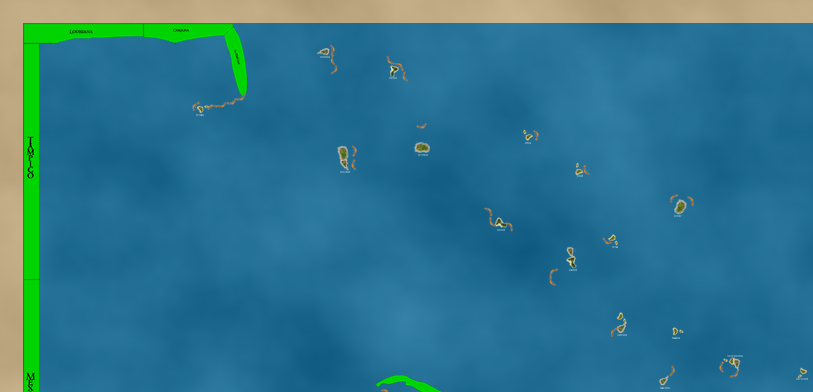
Continuing south, you can see Mexico and Southern Mexico as territories in the far west. This picture shows most of the Greater Antilles, comprised of 8 islands.
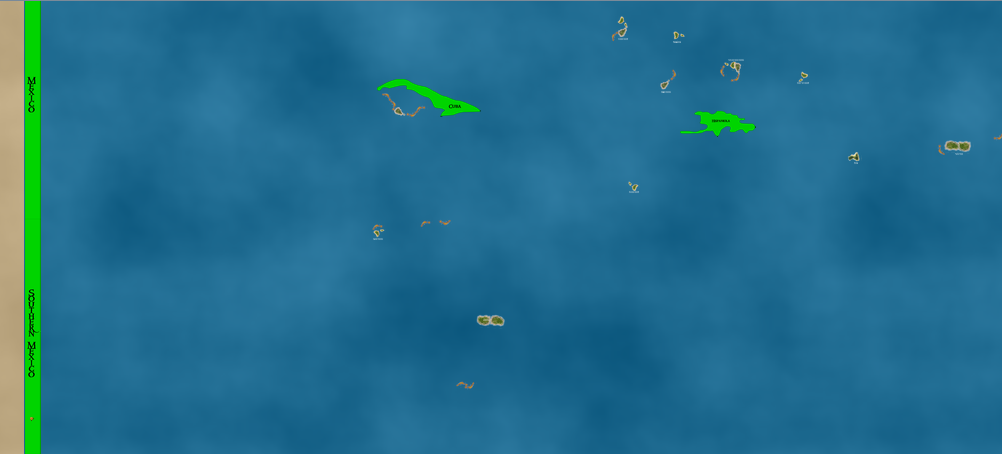
Moving to the northeast, we come upon the vast expanse of the sea and the Lesser Antilles.
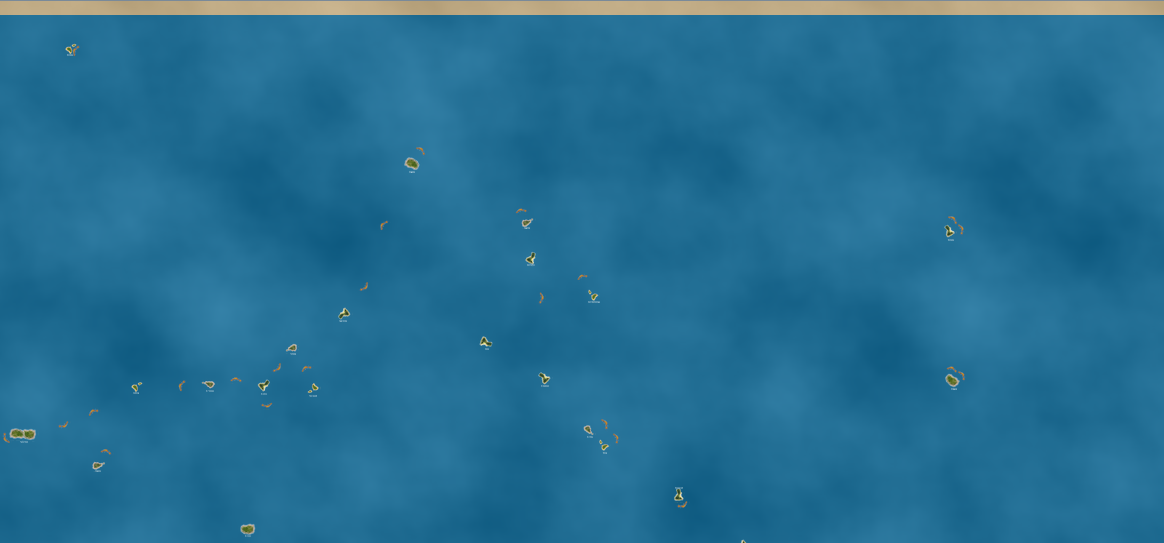
In the southeast corner is the main island chain running north-to-south that includes some of the most important islands in the history of the West Indies. With factions sailing in from the east, it will also be possibly one of the busiest regions in the early part of the game. The Lesser Antilles as a whole comprise the largest region by map size and land locations, with 39 islands in the region.
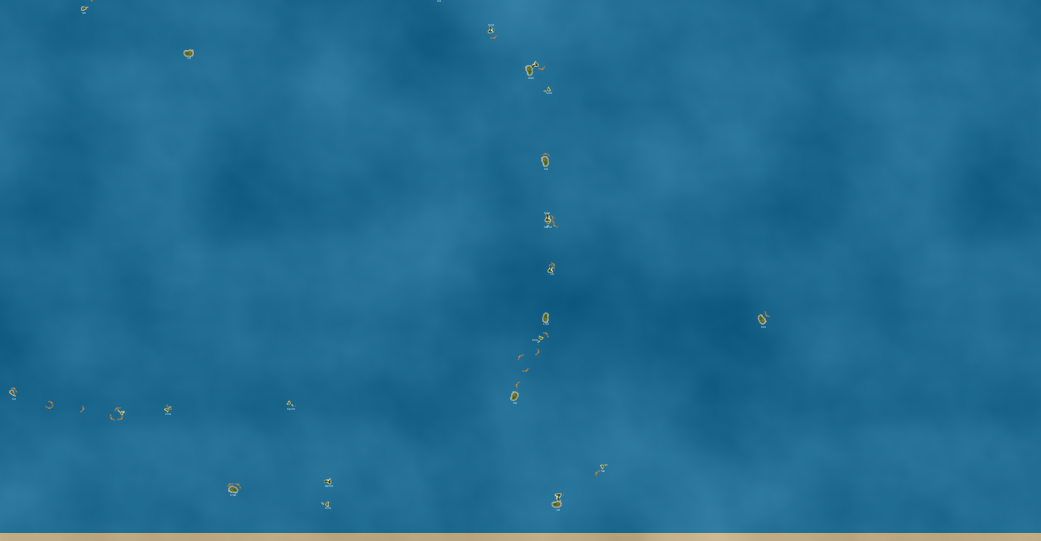
Finally we come to the southwest, the region I’m calling the “South/Central American islands”. There are 11 islands in this region (Aruba and others are pictured to the east, but I looked it up and they are considered part of the Lesser Antilles). In addition, the southern hemisphere territories include Veracruz, Tabasco, Campeche, Honduras, and Yucatan. I really wanted to make the Florida/Yucatan channel closer, but it’s just not feasible with the constraints we have. I was pleasantly surprised with how many islands I found in the southern part of the Caribbean and Gulf of Mexico, so hopefully there won’t be a lot of “dead zones” in the long-term.
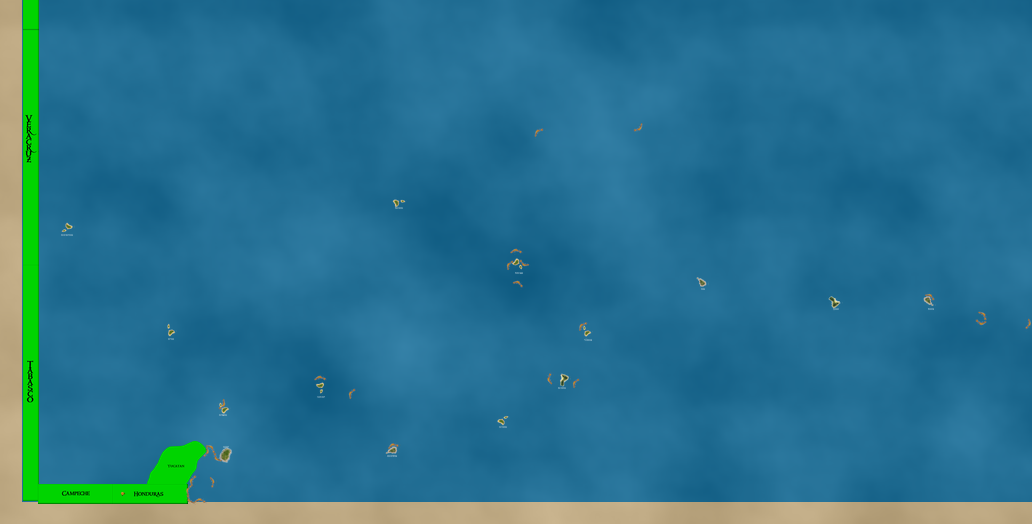
THE RACE TO COLONIZE THE CARIBBEAN IS ON!!!!
Recently discovered by a single European ship now repairing back in Europe, the Caribbean is open to exploration!! It could be considered to be the “year 1500” and the major powers of Europe are sending vessels across the Atlantic to seize new territory! However, they don’t know what’s out there, and may be shocked at the sheer size and scale of the venture….
In the order of play, here come the factions!! ![]() As detailed in the ruleset, we started with 20 point faction-pure fleets with no 0LR +5 crew.
As detailed in the ruleset, we started with 20 point faction-pure fleets with no 0LR +5 crew.
The English, controlled by Xerecs, The Lord Sentinel. They have chosen two capacious ships to send west, with HMS Hound and HMS Cumberland on the scene. Both carry a helmsman, explorer, and oarsman.
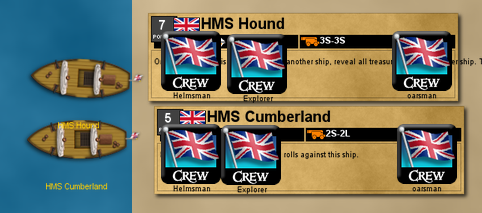
The Spanish, controlled by Xerecs, The Lord Sentinel. La Monarca has an explorer, while the Morning Star carries a helmsman.
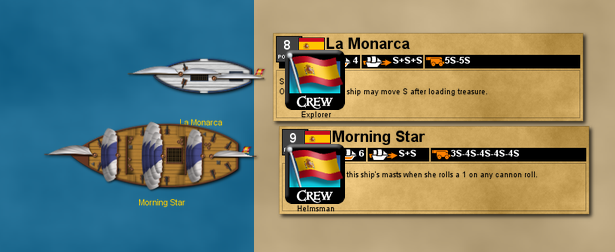
The Dutch, controlled by Admiral A7XfanBen. The historic Prins Willem has arrived with a legendary explorer at the helm: Abel Tasman!
Prins Willem
Faction Affiliation: Dutch
Rarity: C
Type: Ship
Point Value: 14
Number of Masts: 3
Cargo Space: 5
Base Move: S+S
Cannons: 3S,3L,4S
Ability: Crew do not take up cargo space on this ship.
Abel Tasman

Dutch
Crew
6 points
Ability: SAT (Born Leader). Helmsman. Explorer.
The French, controlled by Admiral A7XfanBen. The French also have a historical “all star” in their starting fleet they’ve sent to the Caribbean: Robert de la Salle aboard La Belle! They are also sailing in with the Terron (another historical custom) and the Jeux.
La Belle
Faction Affiliation: French
Rarity: C
Type: Ship
Point Value: 7
Number of Masts: 2
Cargo Space: 3
Base Move: S+S+S
Cannons: 4S,5S
Ability: This ship cannot be pinned.
Link: Robert de la Salle
Terron
Faction Affiliation: French
Rarity: C
Type: Ship
Point Value: 5
Number of Masts: 2
Cargo Space: 2
Base Move: S+S
Cannons: 4S,5S
Ability: Ship treasure trading. (Once per turn, if this ship carries treasure and is within S of an enemy ship, you may randomly trade one treasure with that ship.)
Robert de la Salle

French
Crew
3 points
Ability: Helmsman. Explorer.
Link: La Belle
With that, a final look at the undisturbed region before the game begins! The factions are starting on the far east side now that they have arrived from Europe. They are placed approximately equal distances apart from one another and only have vague inklings of the other factions in play and where they might be. They have been placed north-to-south according to their latitudes over in Europe. North to south: English, Dutch, French, Spanish.
If you want to really study the map and check out the locations, click on the picture below, then click to zoom in on postimages.cc. Then right-click it in the new tab and hit “open image in new tab”, and zoom in again. Then you can see the full picture in all its glory, at 9800×5000 pixels. O_O (may take a little time to load)

This is a combined report, so I have integrated part of Xerecs’ writings into this first battle report for the game. Some of the events may be slightly out of order, but we took a lot of turns and things were happening quickly as the session went on. However, this is the last time we will do this, as it gets far too confusing! XD After this report we will do separate reports; I’ll be covering as much as possible, but we’ll also be doing reports for our specific fleets.
We also streamed live to youtube, which we hope to do frequently with the live sessions for this game. You can hear our excitement and banter in the video, where we recorded all of the first session.
| Xerecs wrote: |
The English are the first to go in this ‘endless’ game, and their two ships the Hound and Cumberland set sail from the far eastern reaches of the sea. The crew of the Hound eagerly look forward to their adventures and exploits in the name of the crown, while the crew of the Cumberland look ahead to the potentially long voyage with mild apprehension. Sailors can go mad if they’re cooped up on a ship for too long after all…..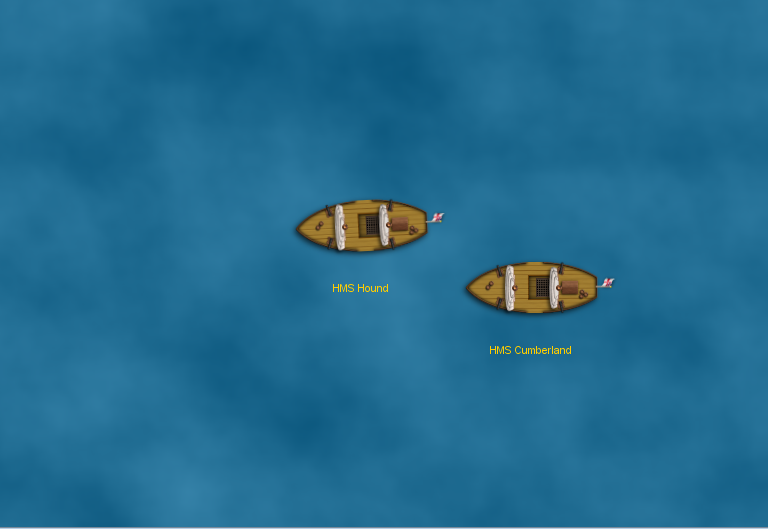 Far to the south, the Spanish began their own voyage with excitement, unknowingly reflecting the sentiment of the Hound. The Monarca and Morning Star will both be able to keep pace with one another, which will come in handy should either ship’s captain suggest changes to their course. Far to the south, the Spanish began their own voyage with excitement, unknowingly reflecting the sentiment of the Hound. The Monarca and Morning Star will both be able to keep pace with one another, which will come in handy should either ship’s captain suggest changes to their course.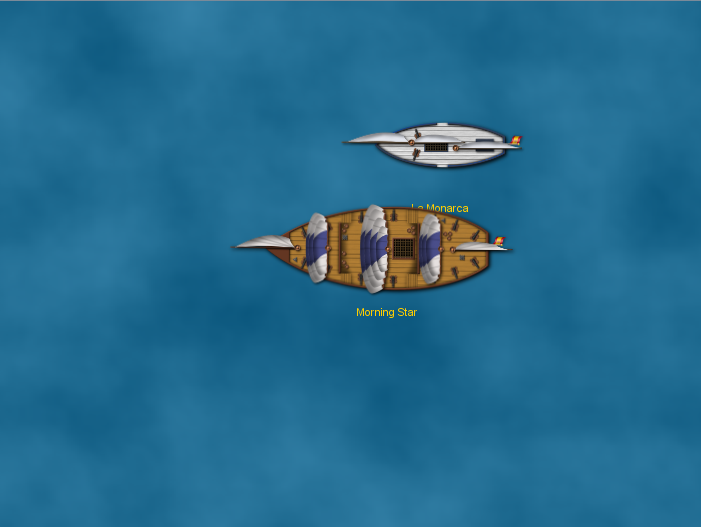 |
The French sail along, with three ships moving at different speeds resulting in being quite spread out over time. Robert de la Salle forges ahead in his ship La Belle, eager to find land and plant the French tricolor!

The English make the first landfall in Barbuda! They would explore to find textiles.
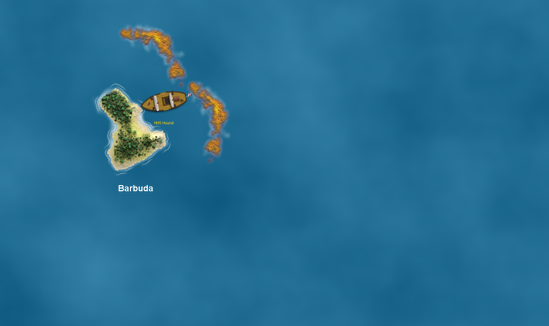
The English sail south and soon come upon Antigua, finding metal! This means the English have explored the two islands in the most northeastern part of the region, but they didn’t like either as a home island due to the reefs nearby.
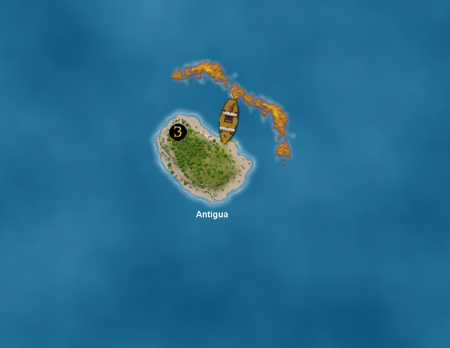
| Quote: |
The English made land ahead of the Spanish, but the journey was not an easy one. With a far superior speed, the Hound has left behind the Cumberland, and found two islands; first Barbuda in the north, and after finding textiles there and finding it not suitable as a Home Island, turned south. The Hound found Antigua soon afterward where Metals were discovered. Since then the Hound has turned back west, while the much slower Cumberland has finally made land at Barbuda. After resting at the island and taking one of the textile tokens, the Cumberland has once again resumed her sail westward, in what the crew believes to be the footsteps on the Hound.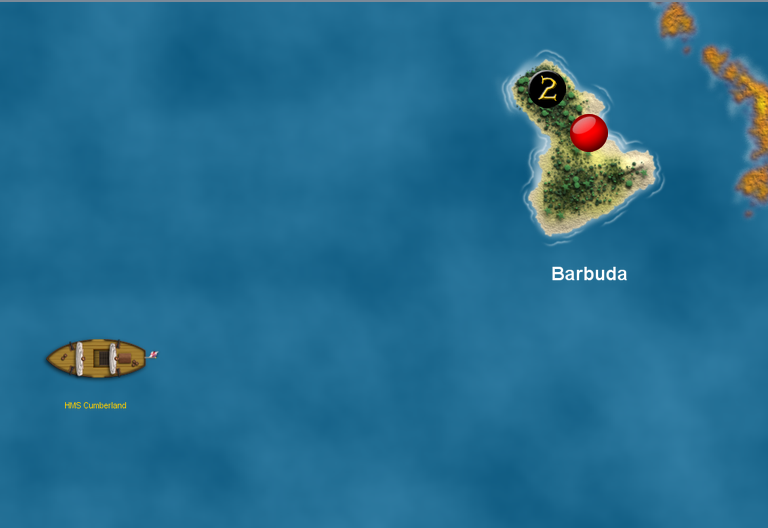 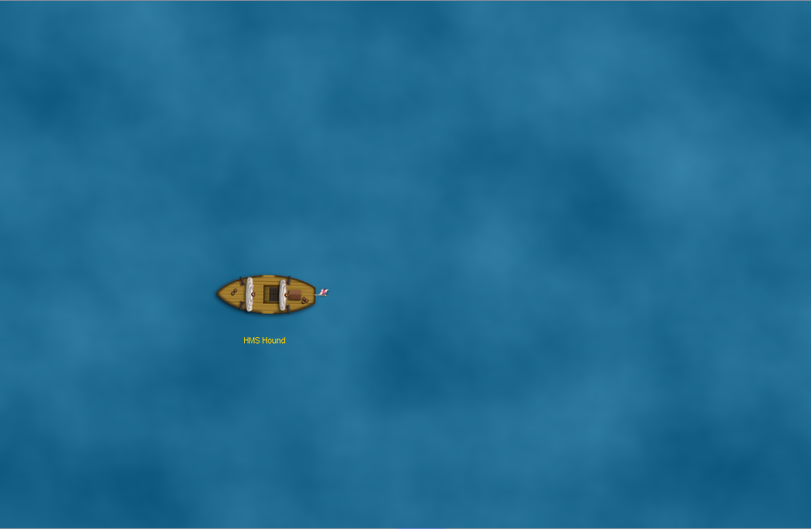 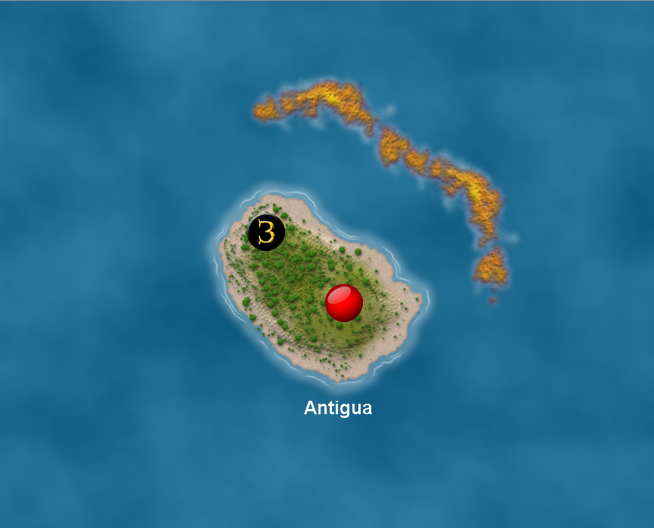 |
Zooming ahead a bit, but the Dutch were the second faction to sight land! With the help of Abel Tasman’s SAT, they were able to explore 4 islands in short order, going northwest and “island hopping” from Montserrat to St. Kitts and Nevis, then up to St. Eustatius. Along the way they find 4 different types of resources – metals, luxuries, food, and lumber!
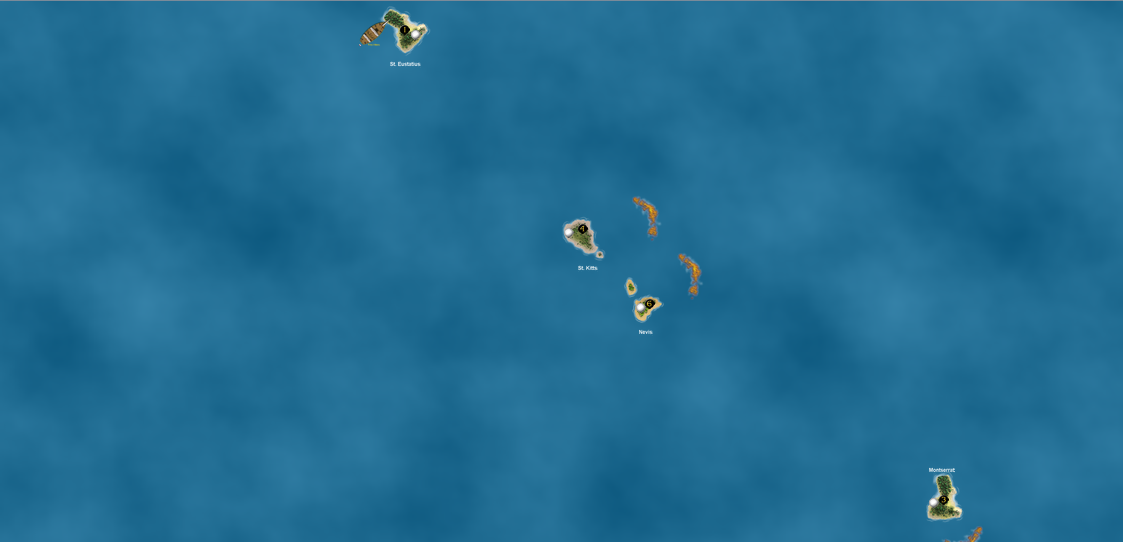
The French find land at last! La Belle approaches Martinique, ironically a French island in the historical Caribbean. Diamond Rock is not a separate island for play purposes – it’s labeled because that’s where the custom Diamond Rock fort can be built.

As the turns go on, the French fleet gets even more separated, with the Jeux and Terron lagging behind La Salle’s flagship.

The Dutch declare that St. Eustatius will be their home island!! With that, they are the first faction to settle on a home island. Wanting to cash in some resources, it was finally time for the first resource rolls! (on Turn 29!) A 6 for values meant that medicine (resource #5) was the most valuable resource, but the values would only hold for 4 turns, not long enough to even affect the other factions!

Cashing in some resources held in the cargo hold of the Prins Willem, the Dutch build the first structure of the game! Spending 10 gold to establish a Level 1 shipyard, they will be able to start construction on one 1 masted ship next turn. As detailed in the ruleset, upgrades of any kind must happen sequentially, and shipyards can only build as many ships as their level indicates. They also scale to the size of the ships, so at max capacity a Level 3 shipyard can build up to three 3 masted ships simultaneously.
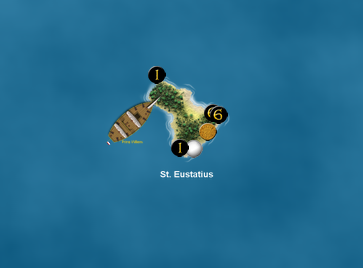
| Quote: |
Some time later, with their stores nearly depleted the Spanish finally find land, the island of Grenada. They will explore it by their next turn, which will give their weary crews a much needed respite.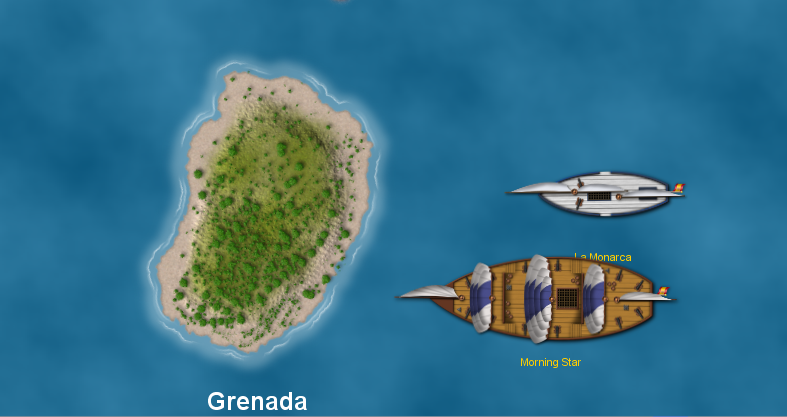 The Spanish have found Medicine on Grenada, of which the Monarca takes one, and the Morning Star takes two. Neither crew is satisfied with the island in regards to a Home Island, given the reef off of the north shore which would make launching difficult. As such both ships turn sharply northward, and decide to follow the reef, in hopes that they have stumbled upon an island chain. The Spanish have found Medicine on Grenada, of which the Monarca takes one, and the Morning Star takes two. Neither crew is satisfied with the island in regards to a Home Island, given the reef off of the north shore which would make launching difficult. As such both ships turn sharply northward, and decide to follow the reef, in hopes that they have stumbled upon an island chain.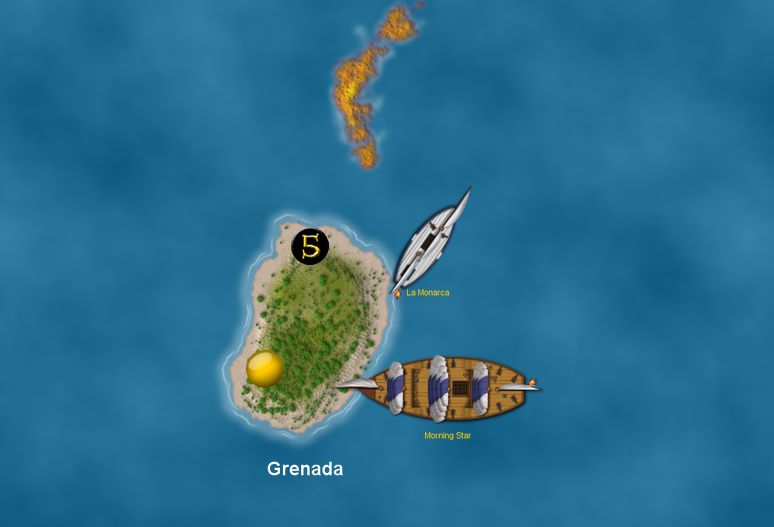 Their hopes and hunches were in the end correct! A few turns later and the Spanish have discovered Grenadines, on which Luxuries were found. After exploring, the Monarca maneuvered around the reefs to move northwest, her smaller size allowing her to fit between the reefs without serious risk. Meanwhile, the Morning Star being larger kept sailing in a northward direction, under guidance from the crew of the Monarca before the two ships became separated by the island. Both ships have spotted St. Vincent, and both crews think that it could make a fine Home Island for them. Their hopes and hunches were in the end correct! A few turns later and the Spanish have discovered Grenadines, on which Luxuries were found. After exploring, the Monarca maneuvered around the reefs to move northwest, her smaller size allowing her to fit between the reefs without serious risk. Meanwhile, the Morning Star being larger kept sailing in a northward direction, under guidance from the crew of the Monarca before the two ships became separated by the island. Both ships have spotted St. Vincent, and both crews think that it could make a fine Home Island for them.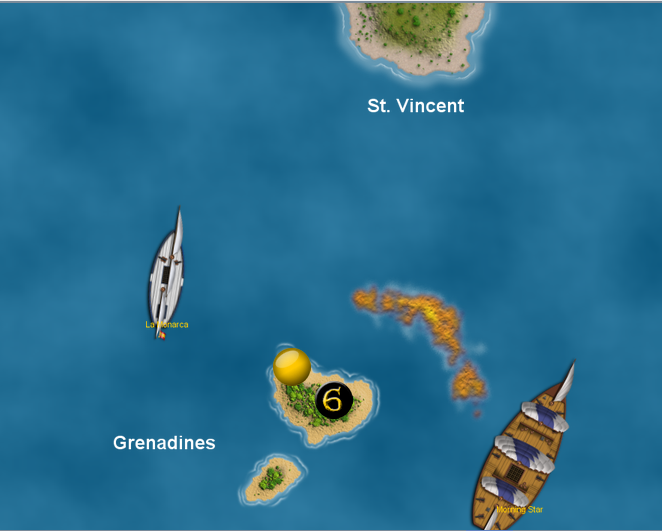 |
After finding lumber on Martinique, Robert de la Salle decides to brave more open ocean, taking La Belle north! The crews of the Jeux and Terron are certainly getting worried, but La Salle specifically instructed them to sail due west until they make landfall, excepting any hostile relations of course.

It was already time for the first actual resource change! (Turn 33) The 1 for values means that every resource is worth its number value (luxuries are the #6 resource and now worth 6 gold apiece), and the duration was for 10 turns, long enough for factions to actually take advantage of the values!

This certainly benefits the Spanish, who have found luxuries on the Grenadines:
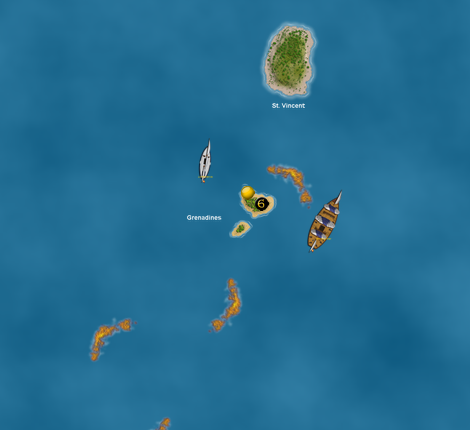
A few turns later and the Dutch are in business! They found medicine (currently worth 5 gold apiece) on Saba, and the Prins Willem has brought some home for a small windfall of 25 gold! With the gold the Dutch purchase the first Tavern, which at Level 1 can be used to hire generic crew and purchase equipment. They also have nearly finished constructing the first new ship of the game, the Limmen! All of my customs and their stats can be found here.
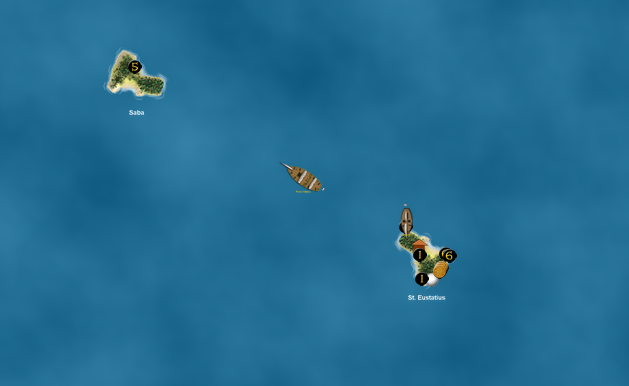
A cheap resource runner with a negative ability to keep the cost down, the Limmen is officially the first ship launched in the Caribbean game. The Dutch fleet begins to expand and their focus is solely on trade and infrastructure.

| Quote: |
A turn later and the Spanish have explored St. Vincent, finding food in the process. Both crews scout the island and the surrounding terrain as thoroughly as they can, finding little terrain that would impede the launching of ships and the conducting of trade. Could it be their Home Island in these waters?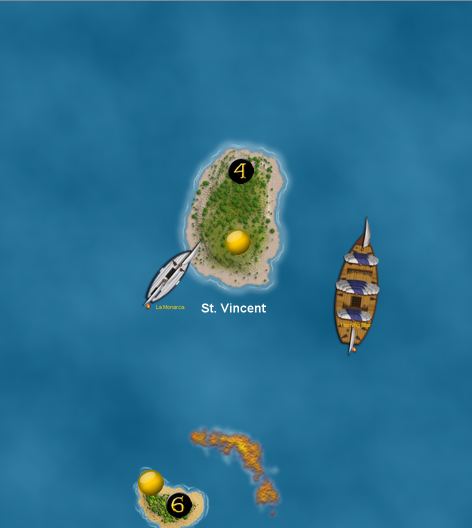 The Answer is a definitive YES! Both the Morning Star (MS) and La Monarca unload their medicine tokens, which are now worth their face value of 5 gold apiece! They begin to formulate plans to upgrade the island, likely with a shipyard which will turn it into their HI for the foreseeable future. The Answer is a definitive YES! Both the Morning Star (MS) and La Monarca unload their medicine tokens, which are now worth their face value of 5 gold apiece! They begin to formulate plans to upgrade the island, likely with a shipyard which will turn it into their HI for the foreseeable future.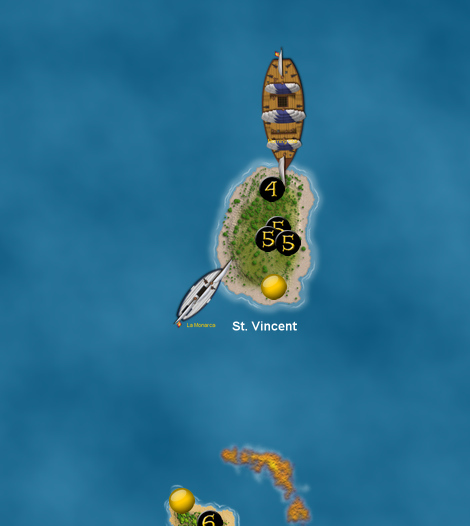 The English have not been inactive, they’ve simply been sailing for a longer time, and have not discovered an island chain as the other factions have. However, that could change as the Hound finds Saint Barthelemy. While it appears to be on the smaller side, from what the crew can see there are no dangerous reefs around the island which would impede launching and expanding. The English have not been inactive, they’ve simply been sailing for a longer time, and have not discovered an island chain as the other factions have. However, that could change as the Hound finds Saint Barthelemy. While it appears to be on the smaller side, from what the crew can see there are no dangerous reefs around the island which would impede launching and expanding.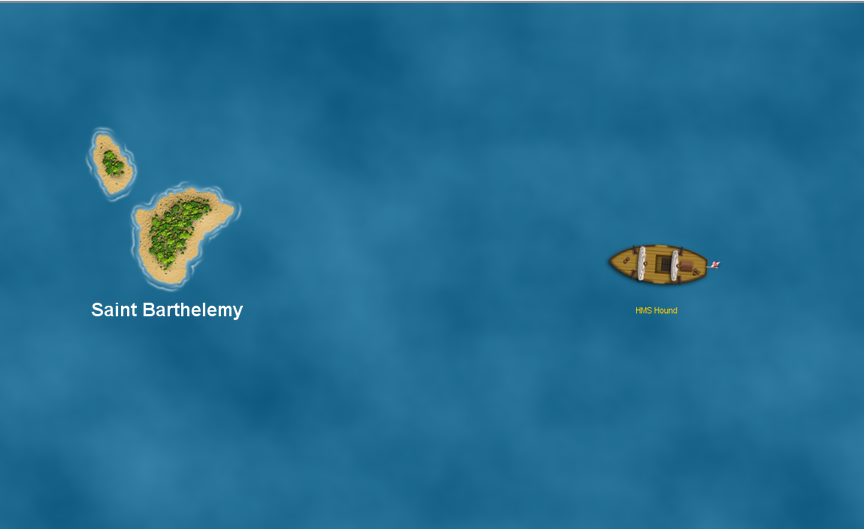 |
Zoomed out quite a bit, and you can see that the Dutch and English aren’t that far apart from each other. The Dutch have planted their flag in a nice 5-island chain running to the northwest, with Montserrat out of the frame to the south. Now that the Limmen has been built and sailed out, the Dutch begin construction on another 1 master.
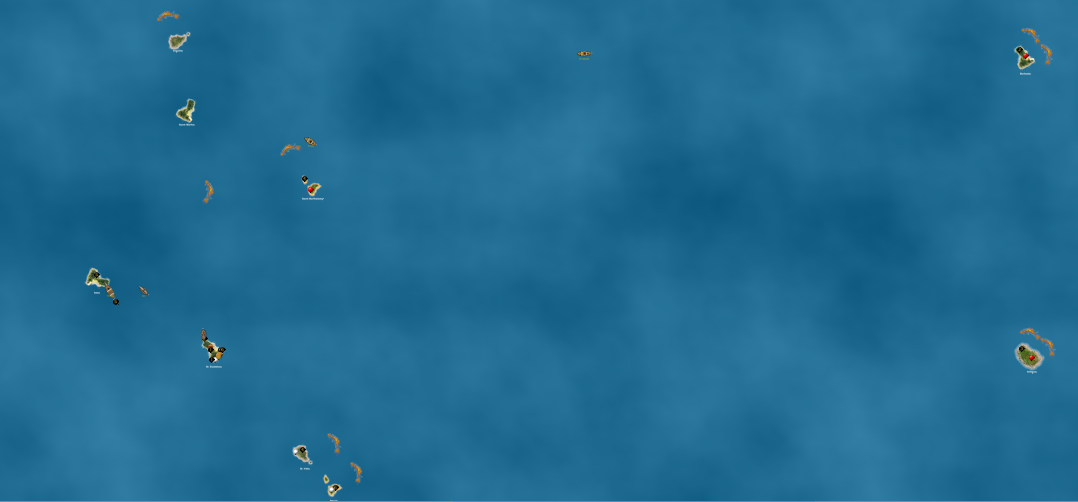
The French situation a bit to the south, where they have made a lot of progress! Robert de la Salle scouted and explored Dominica, finding medicine. Noting the reef on the northern side of the island, he didn’t think it would make for a great home island. However, he sailed north and quickly discovered both Marie-Galante and Guadeloupe! In addition, the Jeux has finally gotten to Martinique, relieved to see evidence of La Salle’s scouting efforts. She loads lumber, slowing her down, and heads north. The Terron brings up the rear.
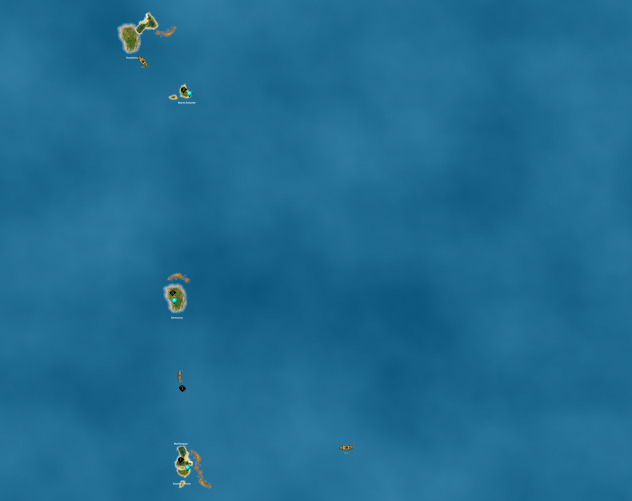
The Spanish situation. They have explored St. Vincent and the Grenadines, while the Morning Star finds St. Lucia!
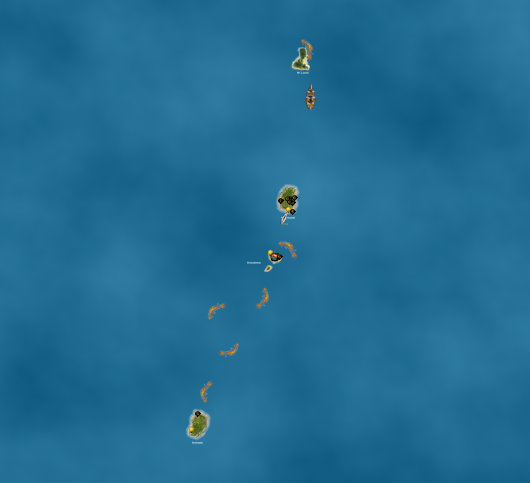
| Quote: |
| An exciting few turns for the Spanish! They successfully upgraded St. Vincent to transform it into their HI! You can see their newly built shipyard on the western side of the island (represented by a yellow token and a 1 coin, to denote it’s level). At this stage, the shipyard can only build one ship at a time, up to one mast ships. With several valuable resources just to their south, the Spanish seem to be in good shape for the immediate future, with enough gold already brought back to launch and begin building the San Leandro! The shipyard and Monarca: 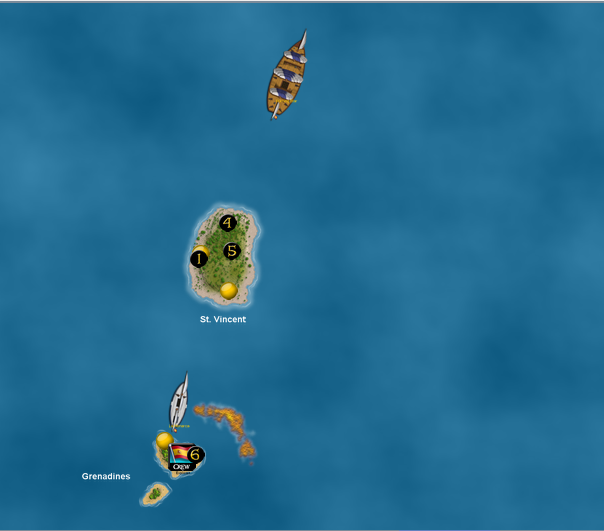 Notice that for the first time the MS and Monarca are splitting up.The San Leandro being built: 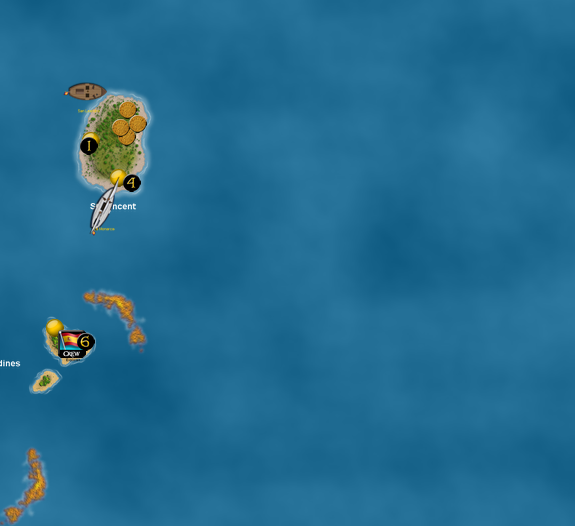 A turn later and the San Leandro is built and ready to sail! She turns sharply northward to follow the Morning Star’s last known heading, hoping to meet up with her at another island. Meanwhile the crew of the Monarca get busy hauling gold around, with another load brought in from Grenadines giving them 43 gold. The Spanish spend a good chunk of it on upgradeing their shipyard, and building a Tavern, from which they can hire crew, spending 20 and 10 gold respectively). A turn later and the San Leandro is built and ready to sail! She turns sharply northward to follow the Morning Star’s last known heading, hoping to meet up with her at another island. Meanwhile the crew of the Monarca get busy hauling gold around, with another load brought in from Grenadines giving them 43 gold. The Spanish spend a good chunk of it on upgradeing their shipyard, and building a Tavern, from which they can hire crew, spending 20 and 10 gold respectively).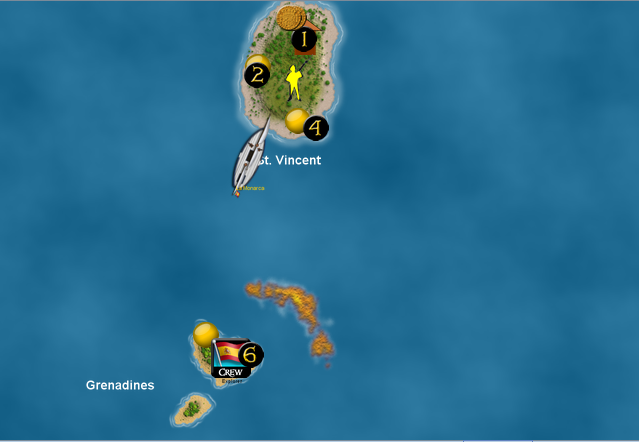 The Tavern is the structure on the north side of the island, with a 1 coin to denote it’s level. |
Taking advantage of the valuable medicine on Saba, the Dutch spend more gold! Cashing in the medicine, they launch the Muis and Heemskerck (1 masted cargo ships here), upgrade their shipyard to Level 2 (next turn it can begin construction on up to 2 ships with up to 2 masts each), and purchase the first island upgrade of the game! The Prins Willem loads the upgrade and the 10 gold used to pay for it. As detailed in the ruleset from the first post, each faction gets a free army unit for their home island, but we may remove them since it is easy to select them and the home islands will be overcrowded even without them. Since the structures tab of the module was mostly for home territories of the World game, we are not likely to use those to represent structures unfortunately, with the exception of taverns since they are small. We generally plan to represent structures and their levels with a neat horizontal line of face up coins (number denoting level) on or just above/to the side of the HI. A lot of things are still up in the air, since the “home island settlement” house rules combine with the upgrade system to make for some confusion as compared to simply starting the game with a home island.
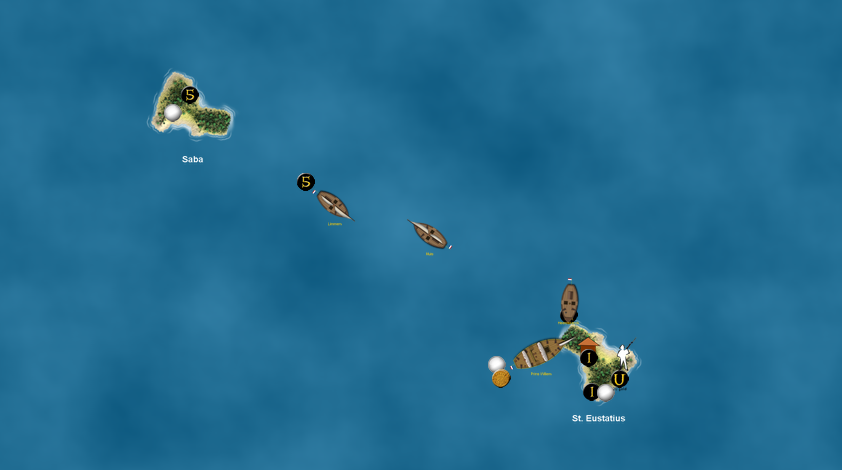
Ironically, Sint Eustatius was part of the Netherlands Antilles for a long time, so it’s perfect as the Dutch home island!
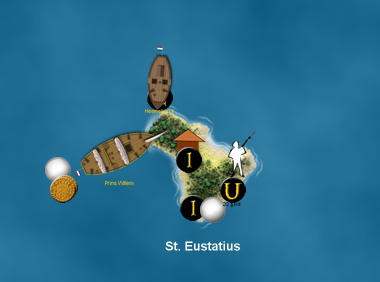
The French decide to settle on Guadeloupe! Robert de la Salle has finished scouting the island, and is satisfied enough to make it the French home island! Luxuries are found on the island, while La Belle has already unloaded her lumber from Martinique. Since Marie Galante is only a single move action away from Guadeloupe, we will be making a house rule that the islands are considered too close to be separate if one of them was a home island. The same goes for the Spanish, where the Grenadines will run out of luxuries at the end of the current resource duration. That island is even closer to St. Vincent than Marie Galante is to Guadeloupe, and of course “St. Vincent and the Grenadines” is how those islands are often grouped in real life anyway. This is all to prevent gamey situations where factions abuse islands right next to their home islands for maximum profit.
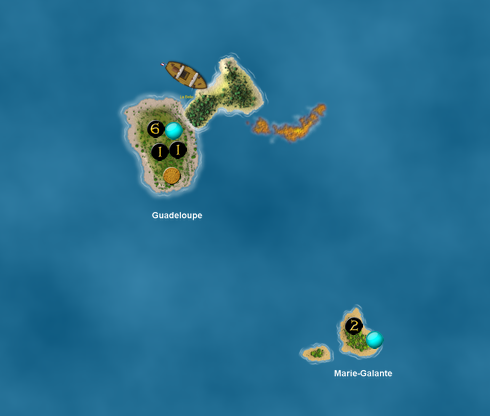
| Quote: |
As the first session came to a close, the Spanish found themselves doing reasonably well. They had established a Home Island, have the top 4 most valuable resources close at hand, and have begun to expand their fleet.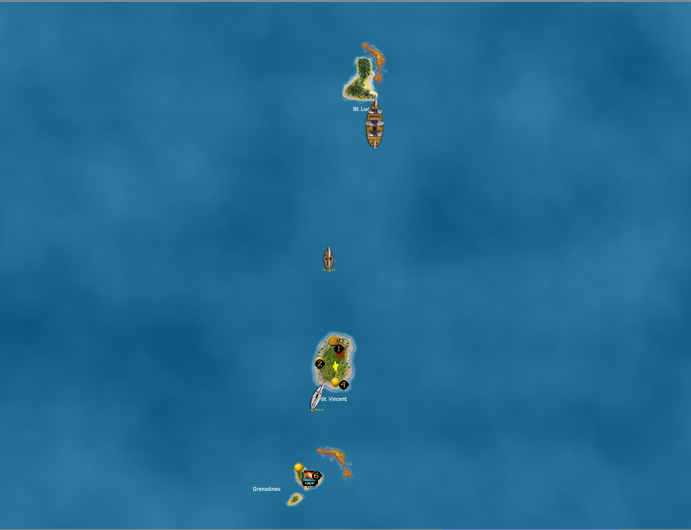 The English have not done as well as the Spanish, but are making strides to catch up. After exploring Saint Barthelemy, the Hound moved north west and has discovered Saint Martin, which from first scouts and explores seems like a suitable island to make into a Home Island, as there are no reefs close to it, and it is a sizable island. The Cumberland is slowly making her way toward the small cluster of islands the Hound has stumbled into, once both ships meet and catch up, they will decide on a location from which to grow……. The English have not done as well as the Spanish, but are making strides to catch up. After exploring Saint Barthelemy, the Hound moved north west and has discovered Saint Martin, which from first scouts and explores seems like a suitable island to make into a Home Island, as there are no reefs close to it, and it is a sizable island. The Cumberland is slowly making her way toward the small cluster of islands the Hound has stumbled into, once both ships meet and catch up, they will decide on a location from which to grow…….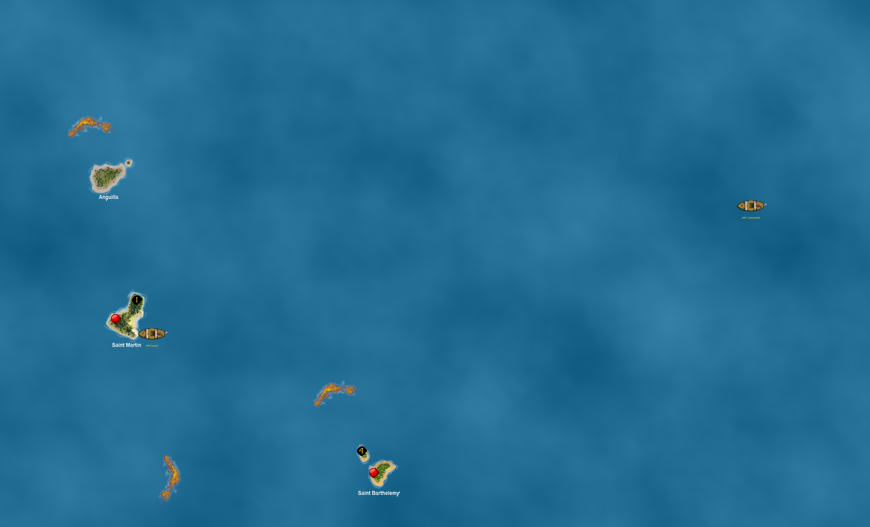 |
With their Level 2 shipyard, the Dutch have begun construction on the Galias (a 2 master with 4 cargo spaces and S+L speed) and now have 5 total ships in play.
With that, the first session of gameplay is complete! We are exactly 40 turns into the game! There are only 2 turns left until the next change. The Dutch and Spanish are off to the fastest starts, but the French and English have been doing well of late now that they’ve made landfall. There is so much more to come that it would boggle the mind, so stay tuned!!
3/15/2018 – To govern a province….
We have played the second live session!
Note: Some of these pictures may be out of order slightly in the sequence of events. The turns are still going by quite quickly, and when it’s not my turn I’m constantly taking pictures and updating the spreadsheet we’re using for turn counter, upgrade stats, etc. My historical customs can be found here.
The Prins Willem carries the first wild island upgrade of the game towards Saba!
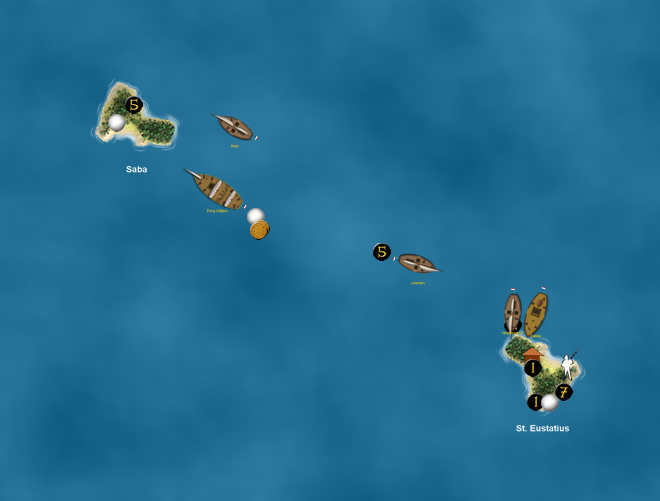
The Dutch have the first colony of the game! Saba is now a colony of the Netherlands, and the Dutch are off to a strong start with valuable medicine and a good fleet to haul it with.
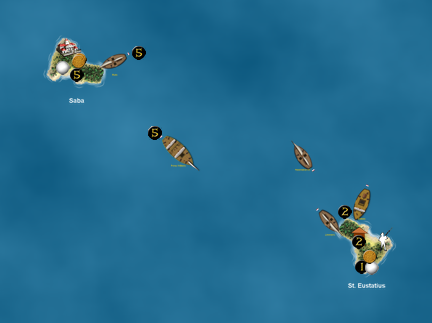
To the southeast, the Terron finally reaches land! She loads lumber from Martinique and heads north after seeing an arrow on the beach left there (by de la Salle of course). The Jeux reloads her resources and also heads north, where La Belle has taken aboard some textiles from Marie Galante.
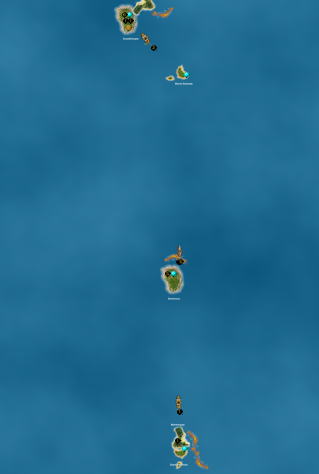
Soon after we started play, the resources changed. A 6 for value and 8 for duration meant that the Dutch would be even richer than they already were! (medicine worth 6 gold apiece) This also marked the end of resource production on Marie Galante and the Grenadines, the “partner” islands of the French and Spanish HI’s respectively.
The Spanish operation at St. Vincent:
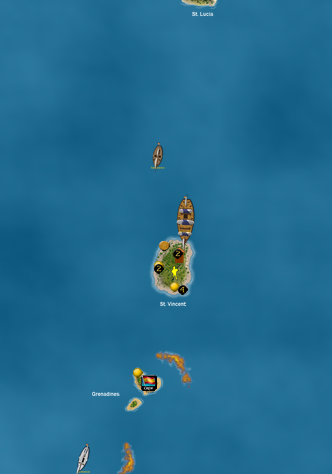
Sailing due west in his appropriately linked ship Duyfken, the famous Willem Janszoon has been hired by the Dutch to explore west of St. Eustatius! The Dutch have also begun construction on the slow but capacious Oliphant.
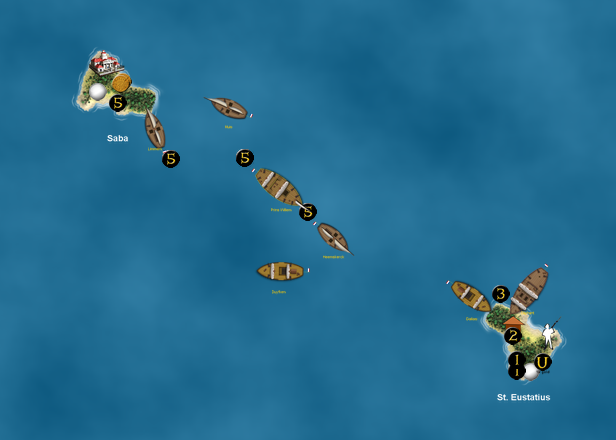
The Cumberland sights St. Martin:
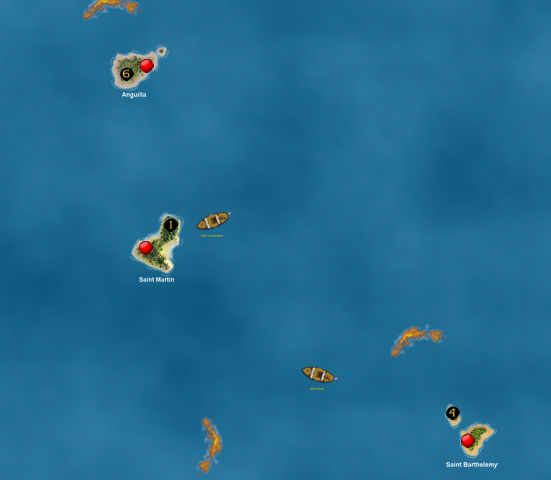
Having launched the San Francisco and Algeciras (SCS version), the Spanish go north to get resources from St. Lucia.
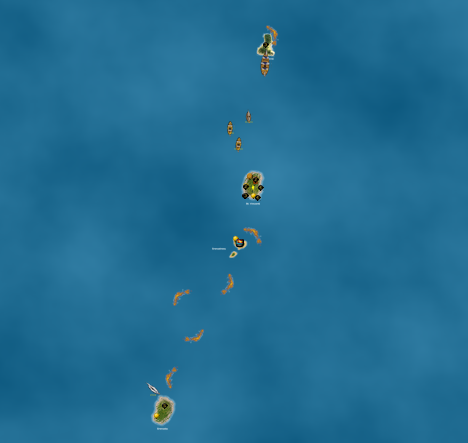
THE FRENCH CREW HAVE HOPE!! Frenchmen aboard the Jeux sight La Belle for the first time in a while, rousing a cheer from the deck. Robert de la Salle smiles and signals that he is going south to pursue the valuable medicine on Dominica.

The English decide to make St. Martin their home island!! The island currently produces lumber, with food and luxuries nearby.
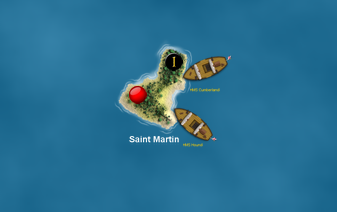
In a somewhat momentous event, the Dutch build the first City in the Caribbean!! Spending a whopping 50 gold to get a Level 1 city that will increase their populace by 3 each turn, the Dutch are in business. When a faction purchases their first city, they also get a free City Hall as well – this means the Dutch are the first faction to get one, and next turn they can potentially start hiring politicians or doing governmental things. Yet another ship is being constructed at their shipyard, while Willem Janszoon ventures west in the Duyfken.
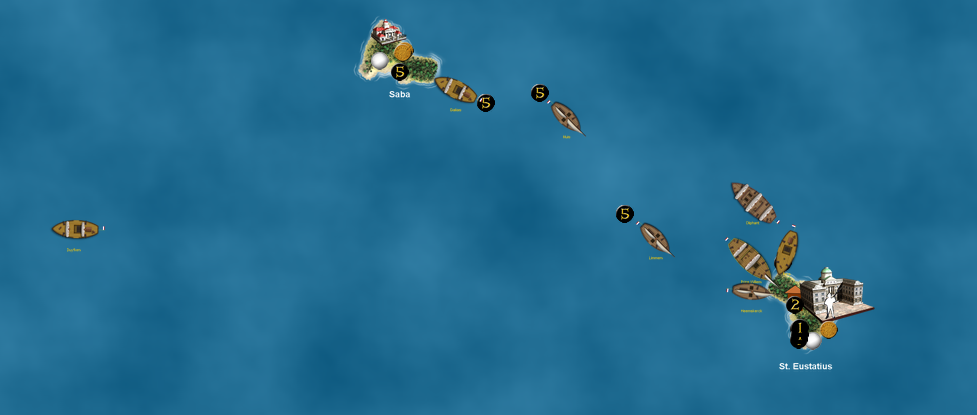
The English split up, happy to finally have a home island:
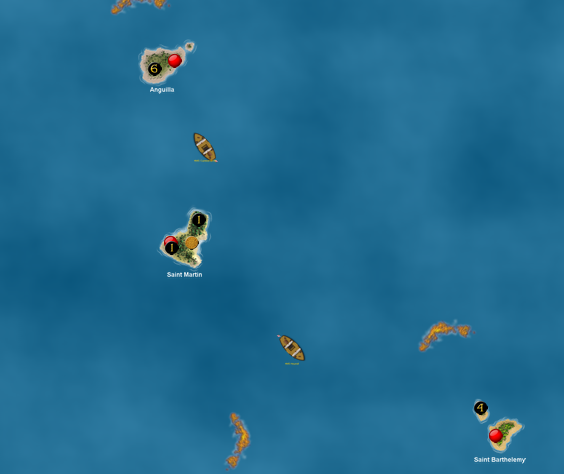
With their shipyard at Level 3, the Dutch begin construction on the Ridderschap, which will be helmed by none other than Philips van Almonde.
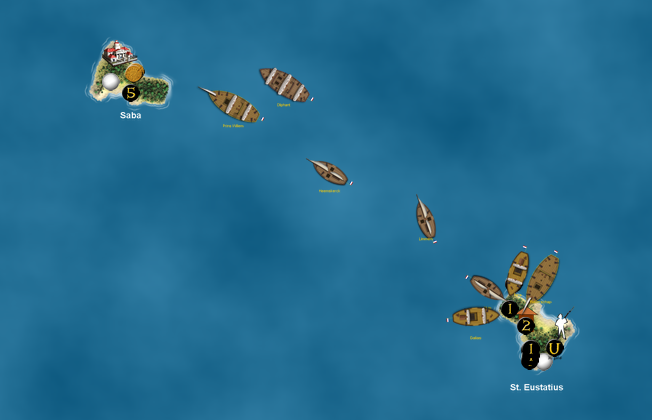
At some point during the session another resource change was needed! This time the value roll was 2, with a 7 for duration. This was great for the Dutch and English, whose home islands produce lumber. For now, we have a rule that home islands produce exactly one resource token per turn. If a faction gets all their structures to Level 2, the home island can produce 2 of that resource per turn.
The French are finally launching some ships! With a Level 1 shipyard they built Le Pique, and here they’ve upgraded the shipyard to Level 2 and have begun constructing the Favori and Bon Marin. The resources unloaded by the Jeux were of maximum values (5 and 6 gold apiece), which gave the French their Level 1 tavern as well. At the bottom, La Belle is already about to lap the Terron, whose crew is just happy to see La Salle again and hear of the great home island of Guadeloupe being set up.
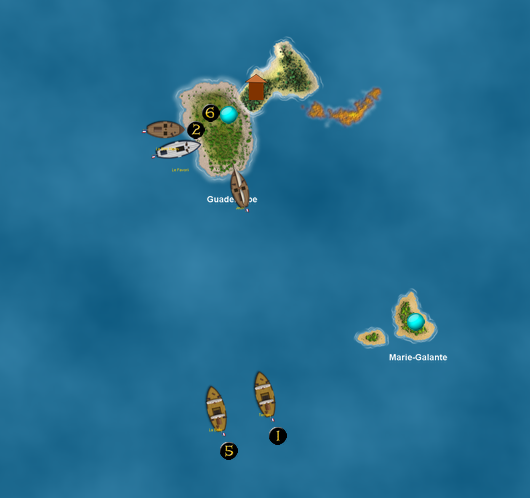
LAND HO!!!! In a huge discovery, Willem Janszoon discovers a trio of islands west of St. Eustatius! The Dutch sent Janszoon due west to find whatever he came upon without changing his course, and here it’s paying off. Peter Island, Tortola, and St. John have all been sighted, and Willem Janszoon looks forward to exploring them soon.
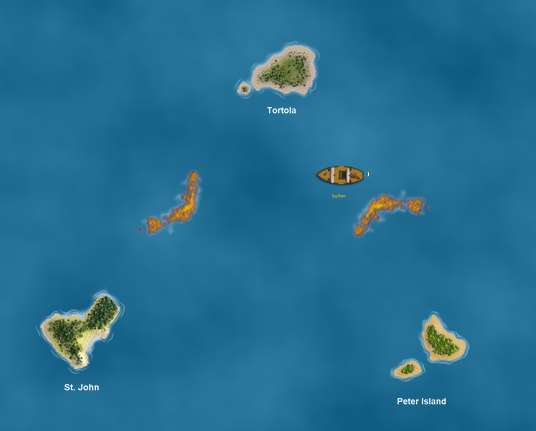
IT HAS HAPPENED!!!! THE COMPLEXITIES BEGIN!! XD
With much excitement, the Dutch elect Olivier van Noort to be their first political leader!! He will head the newborn Exploratory Party!
Olivier van Noort

Dutch crew
4 points
Ability: Helmsman. This ship gets +1 to her die rolls against the Spanish.
Van Noort is proud to be the leader of the new Dutch Government, and carries with him a wealth of maritime experience. Neither of his abilities are land or politician-based, but that’s for a good reason – the Dutch wanted a true seaman and explorer to head their new and untested political system. Abel Tasman had a huge influence on the decision to choose van Noort, and was even considered as a candidate himself. However, Tasman would prefer to be at sea, while van Noort claims he is just fine directing operations from the Dutch home island of St. Eustatius.
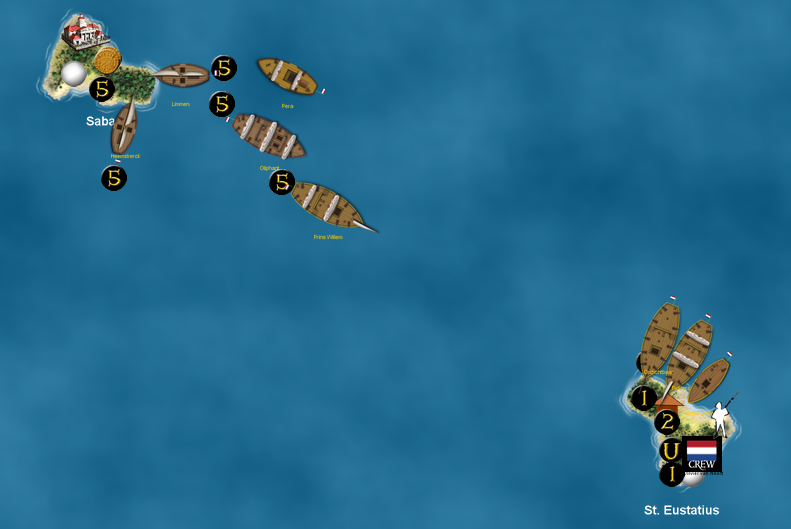
In case you haven’t seen it yet, here are the details of the Exploratory Party:
Exploratory party: Favors exploring every corner of the world, at any cost.
-Army units have a base cost of 4. Three explorers can be hired for just 1 gold. Helmsmen cost 1 gold.
This is exactly in line with the Dutch strategy so far. Abel Tasman and Willem Janszoon are proven capable explorers, and van Noort completely subscribes to their mindset and aspirations. With so much unexplored territory to be gained for the Dutch Republic, it’s in the best interests of all parties involved to have a unified government that seeks to explore the region in its entirety. Van Noort is completely on board with the plan to colonize the Caribbean and plant the Dutch flag wherever possible!
To that end, the Dutch went on another mini spending spree immediately after selecting van Noort. The Snelle Ongedierte is the ship of Adriaen Block, yet another capable Dutch explorer who will map territory for the Netherlands. He is determined to find as many islands as he can, as fast as he can. To the point where there is even talk of a friendly rivalry between Janszoon (who has long since departed on his voyage of course), Block, Abel Tasman (still running medicine with the Prins Willem), and any other Dutch explorers that van Noort sees fit to hire. The fast and expensive Onzichtbaar is also now under construction, joining the Snelle and Ridderschap. Overall it is becoming a glorious time for the Dutch, whose fleet will soon number these 11 ships, and now contains 4 of their prominent exploring minds.
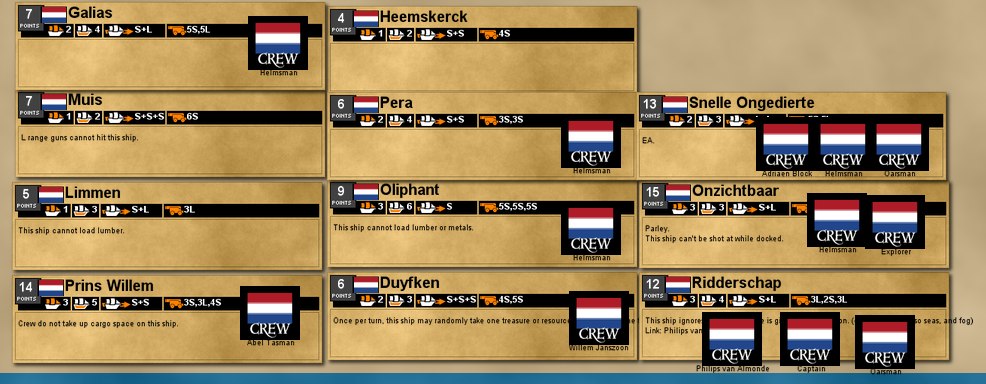
But unbeknownst to them, the Dutch aren’t the only faction in the Caribbean! The Spanish have been doing very well for themselves, becoming the first faction to get their shipyard to Level 4 and beginning construction on three new ships!

St. Vincent is crowded indeed, though a less fortunate resource change and the drying up of luxuries on the Grenadines may slow them in the short term.
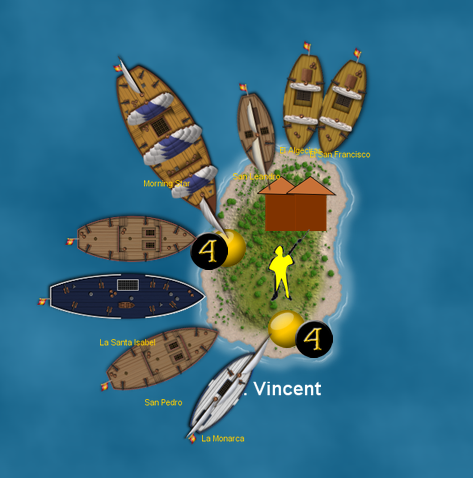
Now for a couple zoomed-out shots. The Dutch and English are actually located remarkably close to each other, with St. Martin only a handful of move actions north of St. Eustatius. At the bottom, you can see that the Dutch have sent two of their ships southeast to St. Kitts and Nevis.
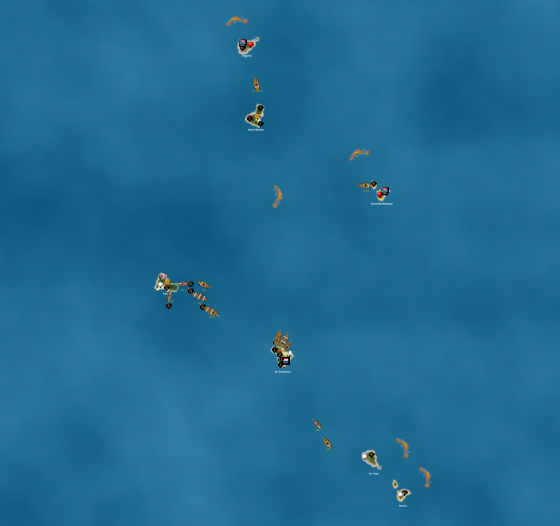
The French and Spanish aren’t as close to each other, but St. Vincent and Guadeloupe lie in the same island chain of the Lesser Antilles.
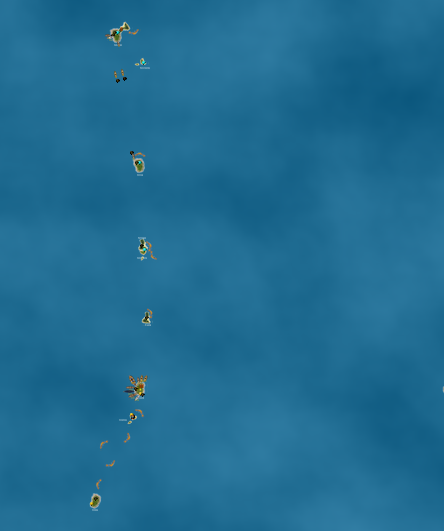
This was an exciting session that saw the first city built and various important developments. The Dutch are getting revenge in a way, since they should have appeared in Pirates CSG long before the Vikings and arguably other factions as well. What a grand opening to a well-deserved faction! We are 52 turns in and looking forward to more!
3/20/2018 – A meeting, a mission, and a governor
If you don’t recognize names or you want information on the Dutch or other historical customs, you can find my custom sets here:
Pirates of the Age of Sail
and Pirates of the Epic Seas
The warm waters of the Caribbean beckon to those looking to make a fortune establishing their trade…
The English continue to get both food and luxuries from the two wild islands near St. Martin.
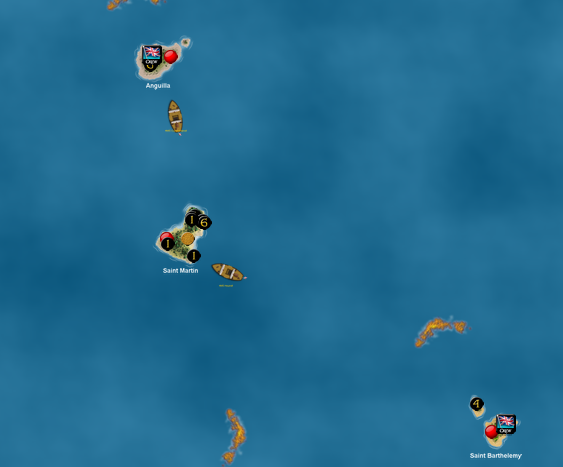
Many Spaniards are busy at work in the shipyard of St. Vincent, where three impressive ships are under construction. The Morning Star has been sent west, presumably to explore and mark new territory for Spain! Smaller ships make trips to the north and south for resources.
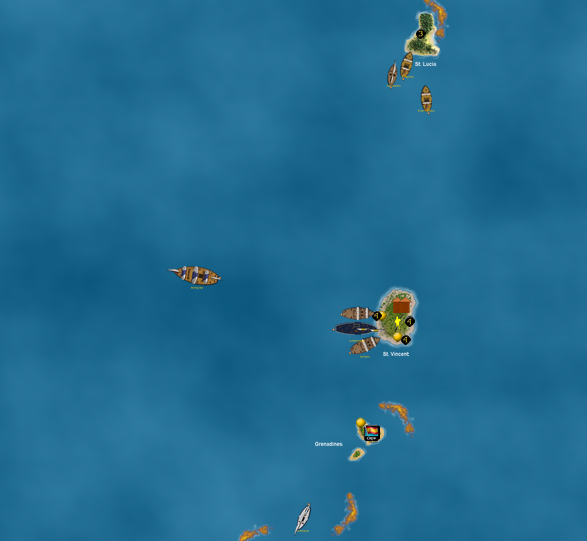
Here come the Dutch! At the far left, Willem Janszoon moves on from Tortola after finding lumber there. At the right, three Dutch ships have gone southeast of St. Eustatius to get resources from St. Kitts and Nevis. These sort of zoomed-out pictures will become more common as factions begin to stretch the prior limits of their explored waters.
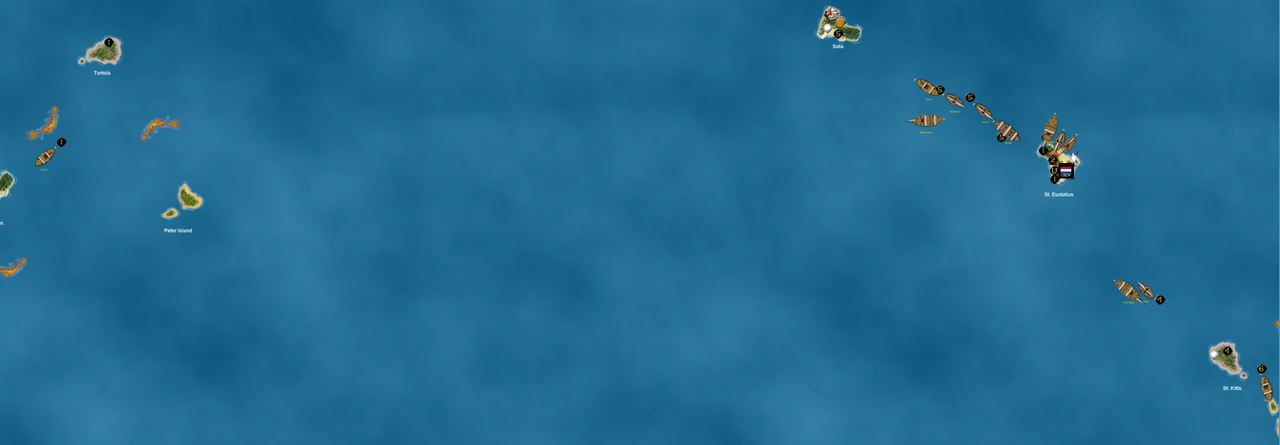
Southeast of the Dutch, the French are constructing two ships and making long trips to Dominica for medicine.
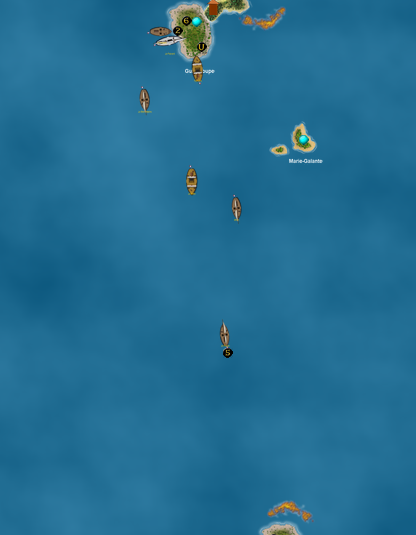
At the left, Philips van Almonde pilots the Ridderschap west. Dutch leader and Exploratory Party leader Olivier van Noort has sent Almonde west to meet up with Janszoon. Van Noort is worried that Janszoon could use support or an escort for the arduous journey ahead. However, with Janszoon’s excellent skills, the Duyfken is still faster than the swift Ridderschap! At the right, the newly launched Vis heads due north as the Dutch upgrade their shipyard to Level 4! At this point the Dutch are the early points leader (unbeknownst to them and the other factions), bringing in resources often, cashing them in, and launching new ships at a fast pace.
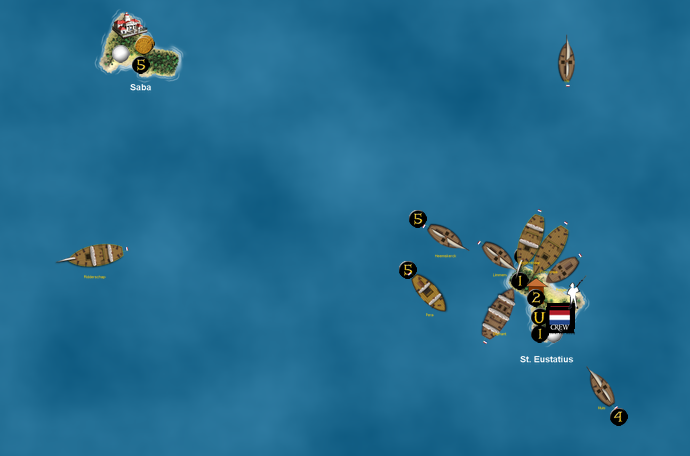
As the French save up for something, the Favori leaves port. Heading north, her crew have disobeyed La Salle’s orders to sail south to Dominica until a stronger presence can be established in the unknown waters north of the French home island of Guadeloupe. At the bottom, you may have noticed that the Terron is finally leaving the French home island – it took her a while (over 50 turns!), but she has finally reached and docked at the French HI!
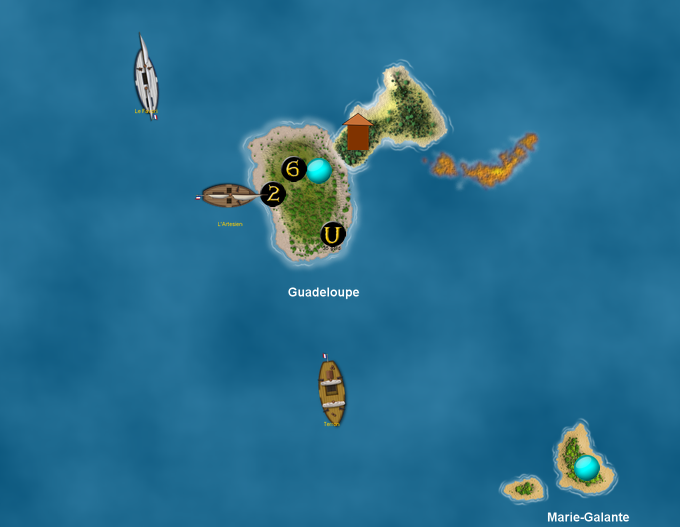
The English spend 40 gold to upgrade their shipyard to Level 2 and buy a Tavern!
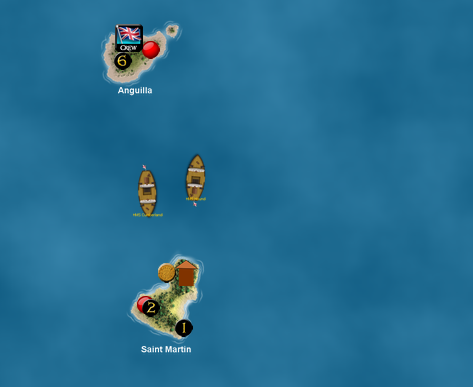
The French reveal what they’ve been saving for! The second city of the game!! This gives them a city hall, so they can begin government operations next turn. Northwest of Guadeloupe, the crew of Le Favori come upon Montserrat, which is the first island in the Caribbean to be discovered by two factions!
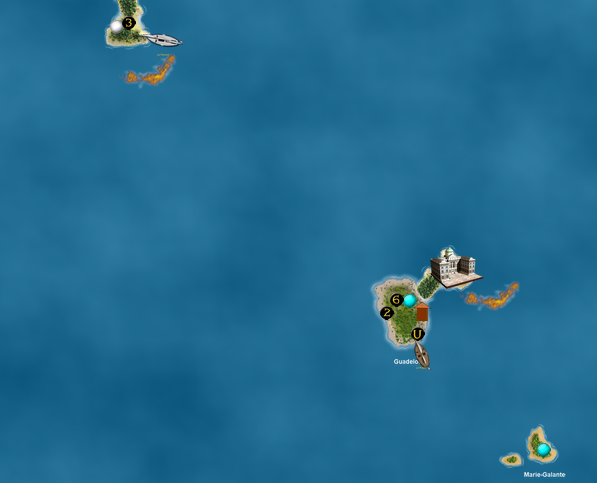
Turn 58 marked the need for new resource rolls! A 1 for values meant that all resources are worth their face value (luxuries best at 6, lumber crashing to 1), the same values as the second resource change from turns 33-42. The duration was for 9 turns, so factions will be able to take some advantage of this time period.

With the very speedy Vis sailing due north, the Dutch discover the English! This is the first contact of the game between any factions! The Dutch came in peace, for the Vis was just one of many exploratory ships christened by Olivier van Noort. Here is how the conversation went:
<a7xfanben> – (captain of Vis, in Dutch XD): Ahoy!!
<Xerecs> – (captain of Honud): Eh?
<Xerecs> – (captain of hound): SPEAK ENGLISH!!!
<Xerecs> – (captain of hound): Who’re you, and where’d you come from?
<a7xfanben> – Dutch captain: wij komen uit Nederland.
<Xerecs> – (CoH): You’re a Neanderthal?
<a7xfanben> – D: wanneer ben je hier aangekomen?
<Xerecs> – CoH: Eh?
<a7xfanben> – D: wat zei je?
<a7xfanben> – D: we kijken ernaar uit om met u te handelen.
<Xerecs> – CoH: Can’t understand a word you’re saying
~~~~~
<a7xfanben> – welp I guess the actual Dutch won’t help! XD
<a7xfanben> – might have to get Tasman up here… XD
<a7xfanben> – Dutch may spend
<a7xfanben> – going to French
<a7xfanben> – a peaceful but confusing first encounter! ![]()
<Xerecs> – English can’t understand a word they said.
As you can see from Google translate or your own knowledge of Dutch, it was a conversation lacking in hostility, but also understanding. XD We’ll see if they can communicate better in the future. Still, a big moment in the game, for neither faction knew of any other nations present in the Caribbean region….

The Dutch continue their spending, with multiple ships constantly being built at their shipyard. The Reijger is one of their new additions, and has been sent due east….
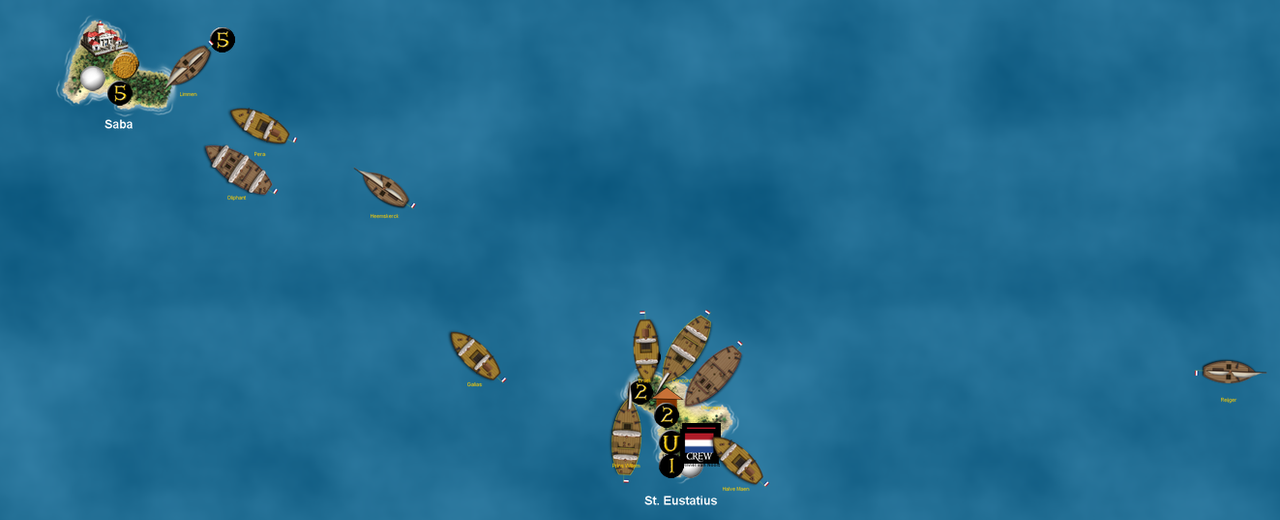
The English break off from the visiting Vis to make some major strides! They build a city and launch their first ship, the Lord Kenyon!
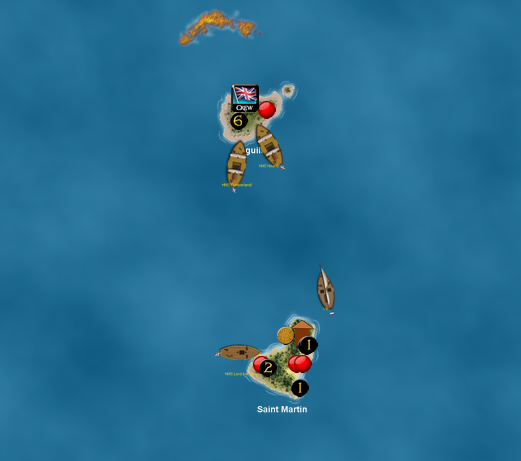
Happy and amused, the crew of the Vis continue speeding due north, noting Anguilla’s English presence as they go. To the southwest, the Onzichtbaar is heading northwest….

The Morning Star is now quite aways from St. Vincent, venturing off into the unknown by herself:
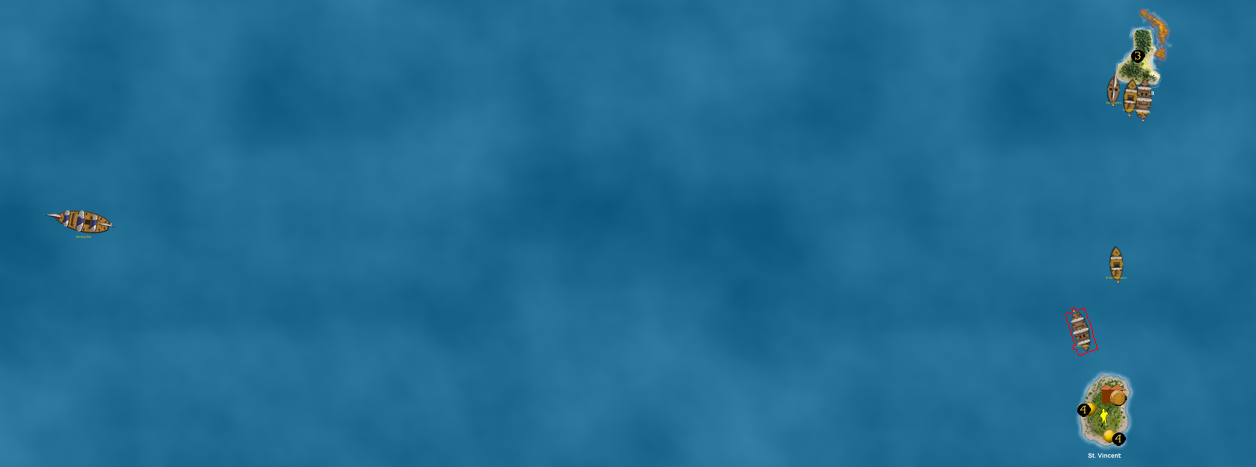
Willem Janszoon is overjoyed! After finding lumber on Tortola, he explored the nearby island of St. John and found metals! Continuing a bit further west (and out of this picture), he discovered a new island! St. Thomas was explored, and much food was found. Truly an “all-star” explorer, Janszoon has now found 4 new islands for the Dutch and explored all of them! (using S-exploring to mark Peter Island) With these very important discoveries and the Duyfken’s hold full of various resources, Janszoon decided to turn for home to inform his comrades. On the way back, you can see he ran into Philips van Almonde! Almonde was just relieved to see Janszoon alive, let alone in high spirits. The Ridderschap is meant to be the Duyfken’s escort, but Janszoon may not be able to contain his excitement and could sail ahead at a faster pace!
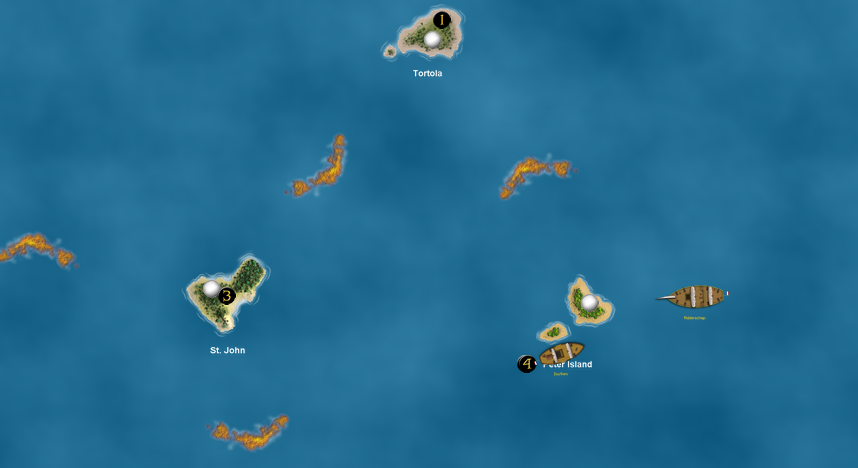
With that and the following pictures, it is time to reveal the Dutch plan!! Olivier van Noort is overseeing the construction of 8 ships that will sail directly in the 8 main directions of the compass rose!
After many turns of building and spending, the “exploratory squadron” is complete! Here you can see the final 3 ships departing from St. Eustatius: the Reijger heads due east, the Concordia (with Joseph van Ghent aboard!) heads southeast, and the Braek heads northeast.
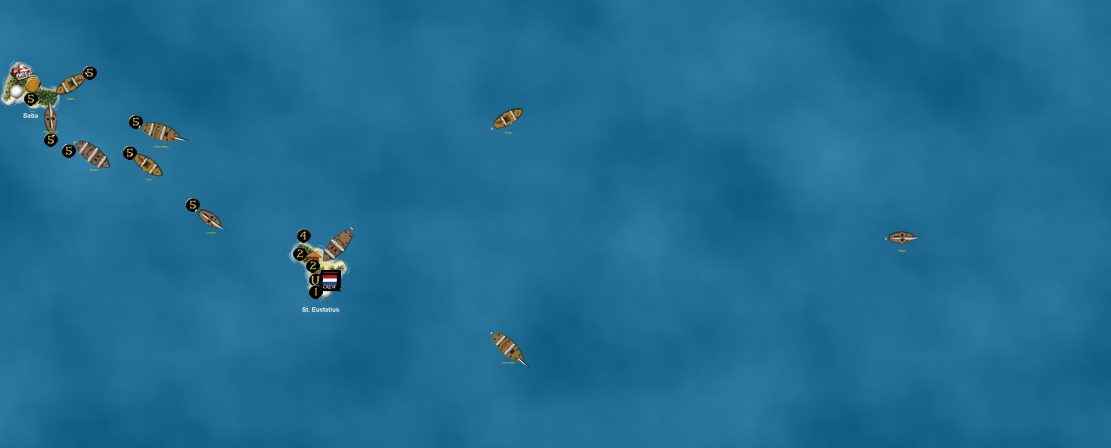
With the Concordia still in the picture, the Halve Maen can be seen heading due south.
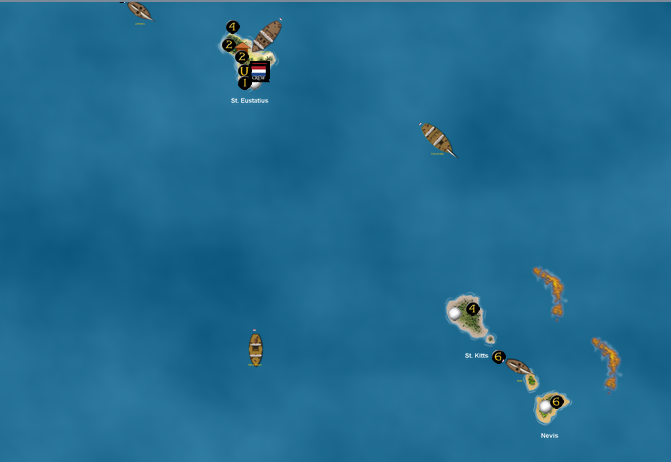
All alone heading southwest, the Snelle Ongedierte has blazing speed and Adriaen Block at the helm.
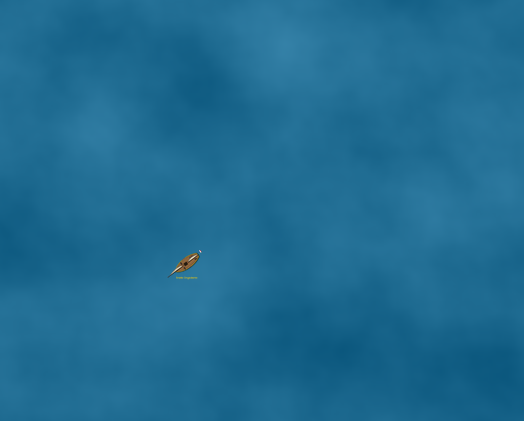
The Onzichtbaar heads northwest:

Clearly the Dutch have big ambitions to explore not only their surrounding area, but possibly the entire region! They have sent ships in all direction as a “probe” of sorts to find out what is out there. In addition, if it’s worth harvesting, colonizing, attacking, or exploring.
In a big move, the English hired Governor Lynch to be their leader and the head of the Sea Party!!
Sea party: Favors naval warfare and expansion.
-Army units have a base cost of 5. Captains and helmsmen only cost 1 gold each.
With that, here are the stats so far from our spreadsheet.
The Dutch are off to the fastest start, with a Level 4 shipyard and both their Tavern and City at Level 2. This means their city is adding 5 to the populace every turn, which the Dutch have a big lead in so far. Van Noort is happy with his progress as leader of the Exploratory Party, and has completed the 8-ship squadron that will explore the region for the Dutch. The French are lagging a bit but have some good things going for them, specifically (currently) valuable medicine on Dominica.
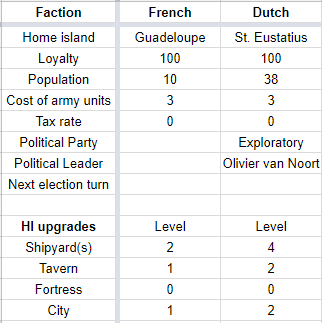
The Spanish are off to a good start, but the English made much bigger news than them in this session, purchasing a bunch of stuff and surprising people by being the second faction to have a government. In addition to the Lord Kenyon, the English have launched the Prince of Chichester.
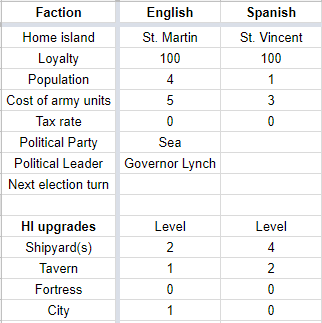
The turn and resource change log. With two value rolls dominating the first five changes, we have already begun talking about instituting the random change rule. It was used to solid effect in Command the Oceans and can be found in the first post. (I will note when it is introduced; we are tentatively thinking around Turn 75)
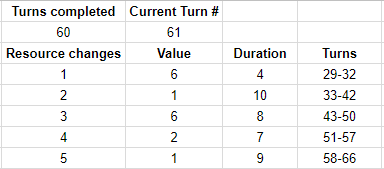
We have completed Turn 61, with a few developments.
Philips van Almonde docks at Peter Island and finds lumber, now the most common resource in the game and the most plentiful that the Dutch have found. Willem Janszoon passes him in the Duyfken, who is on her way home. At the far left you can see the island of St. Thomas.
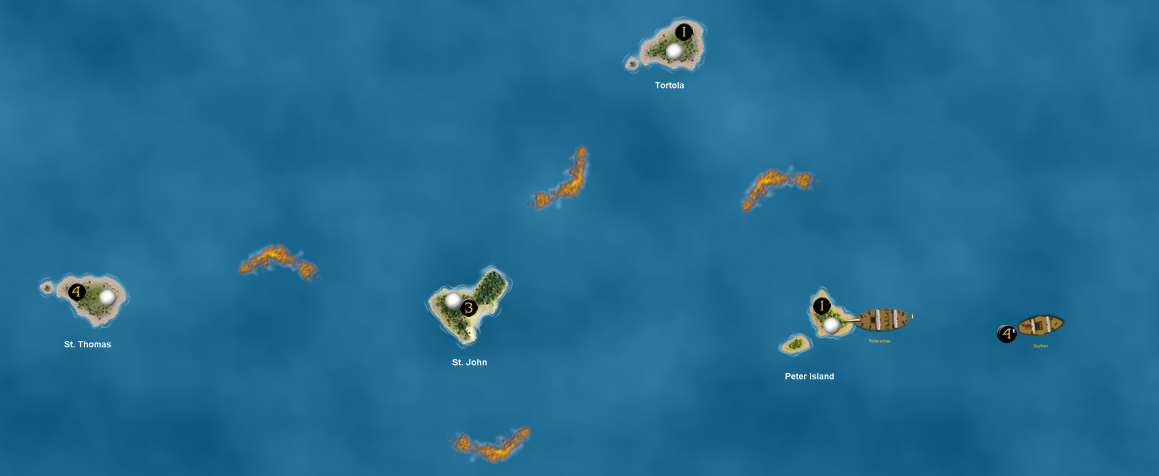
The Dutch launch the Mercurius with today’s historical custom of the day, Steven van der Hagen! The Meermin is nearly ready for action and will be transporting resources to St. Eustatius from nearby islands.

Robert de la Salle gets home at the same time as the Favori, whose crew disobeyed his orders to sail south! However, la Salle is more intrigued than angry after hearing about the discovery of Montserrat and the wealth of metals found there. In fact, la Salle is now excited by the prospect of having another island near Guadeloupe.

The French hire two politicians! Philippe Hurault de Cheverny of the Home Territory Party and Louis de Revol of the Resource Party have been hired for a cost of 10 gold, as neither have any special abilities yet. Next turn will be France’s first election, and indeed the first election of the game!! Emptying the coffers, the French also launched the Courageux with crew, as la Salle is interested in heading a small squadron up to Montserrat in the near future.
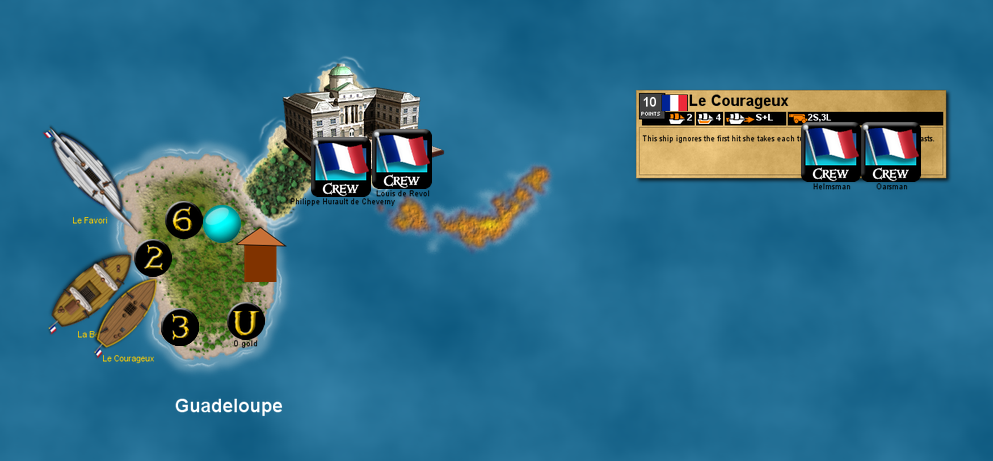
6/25/2018 – An election?
That’s absurd. Wouldn’t you say? But no!! It is happening! ![]()

